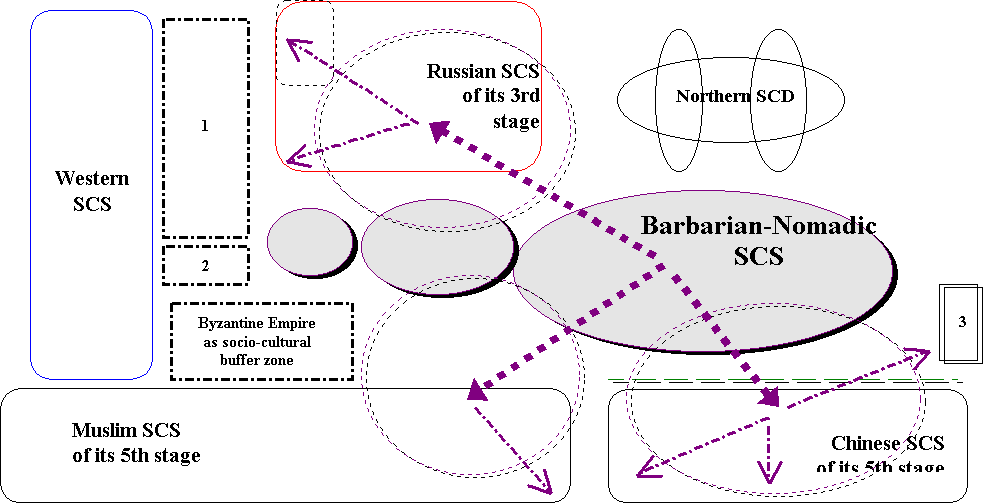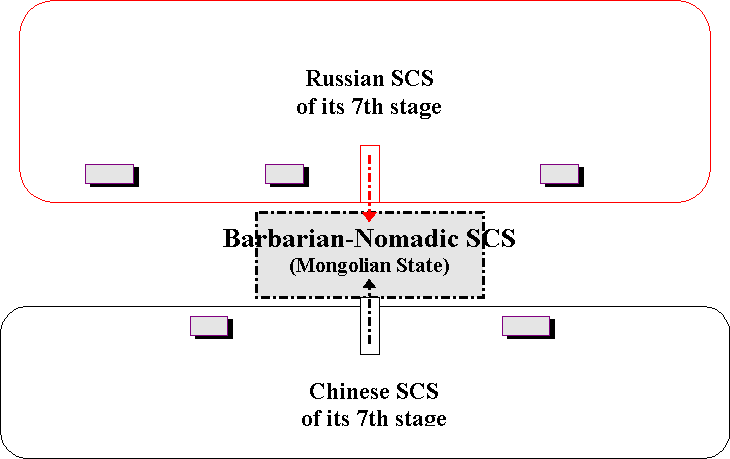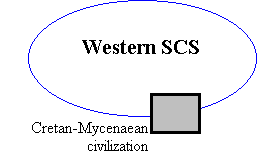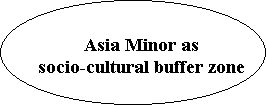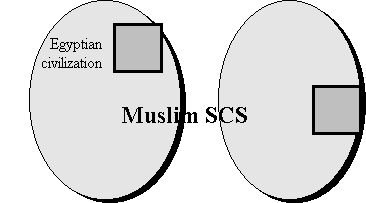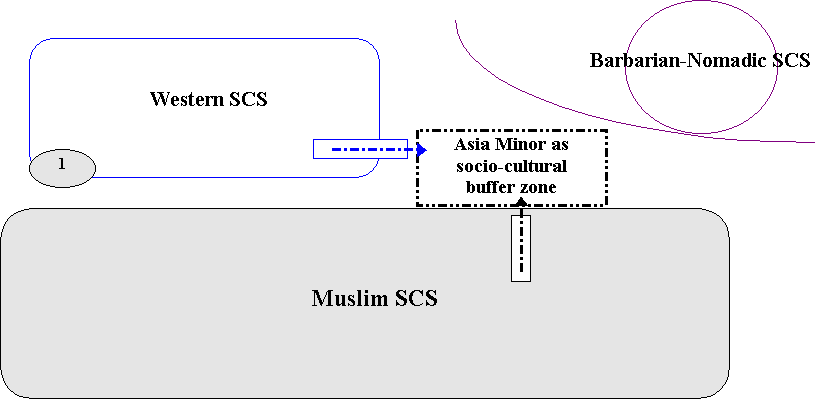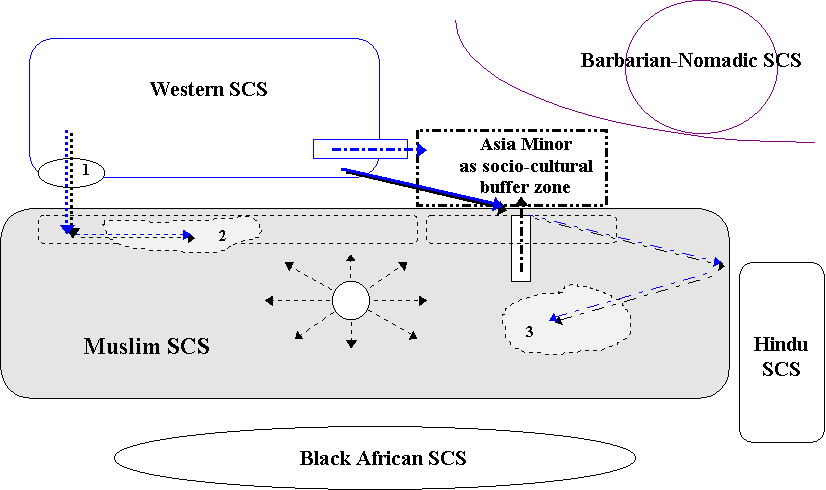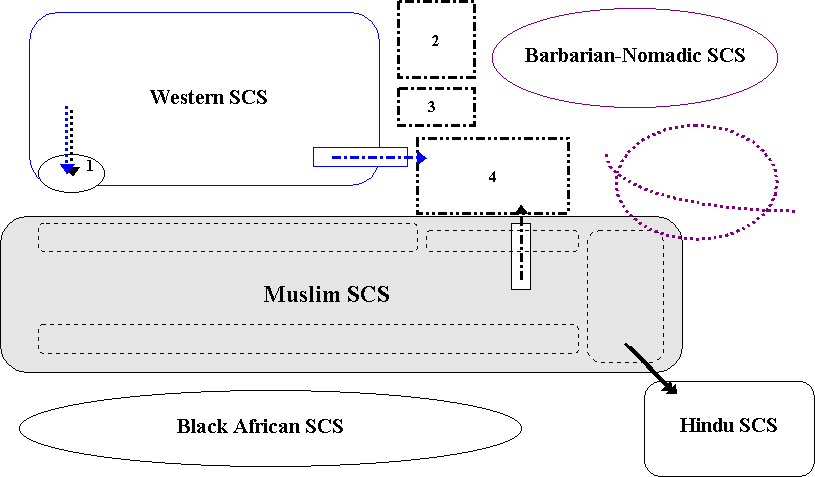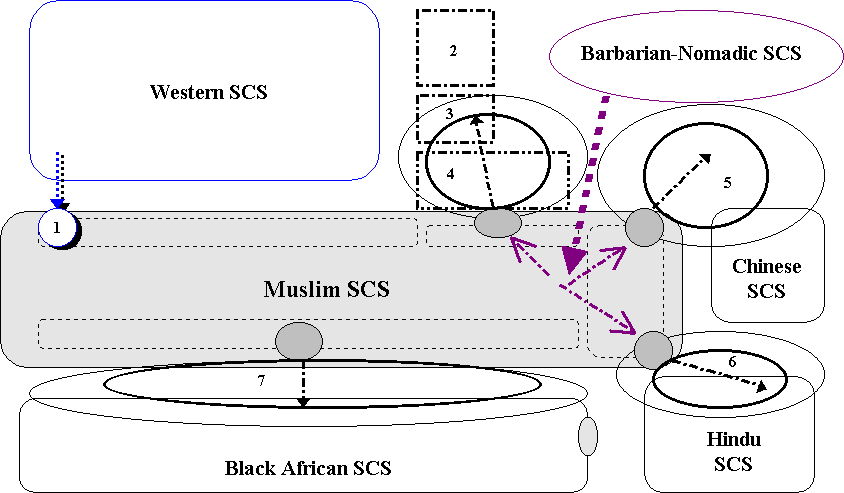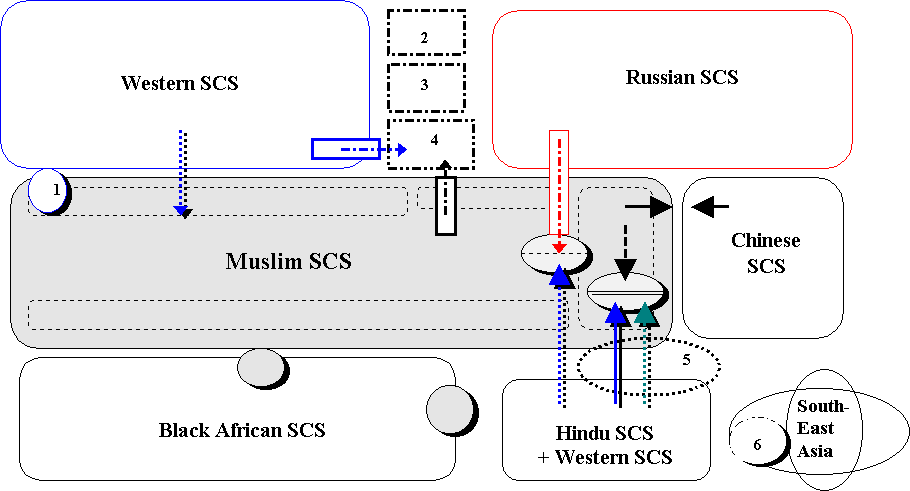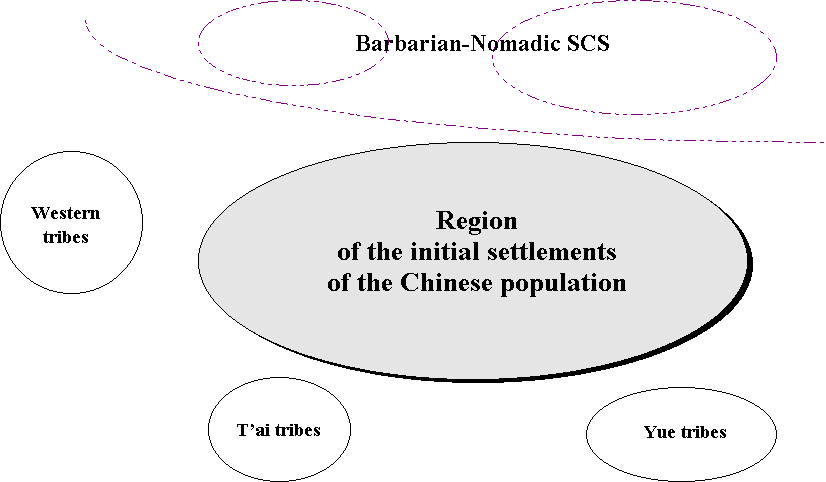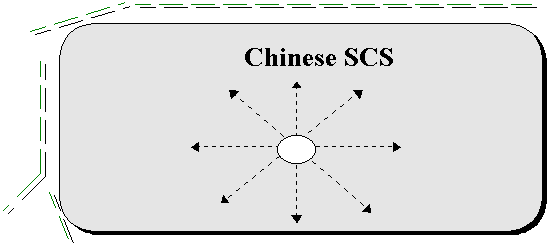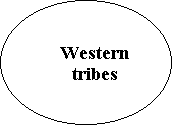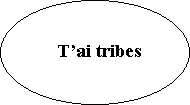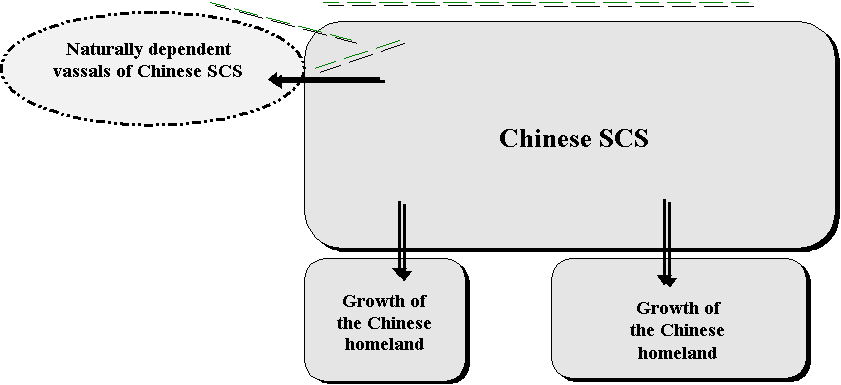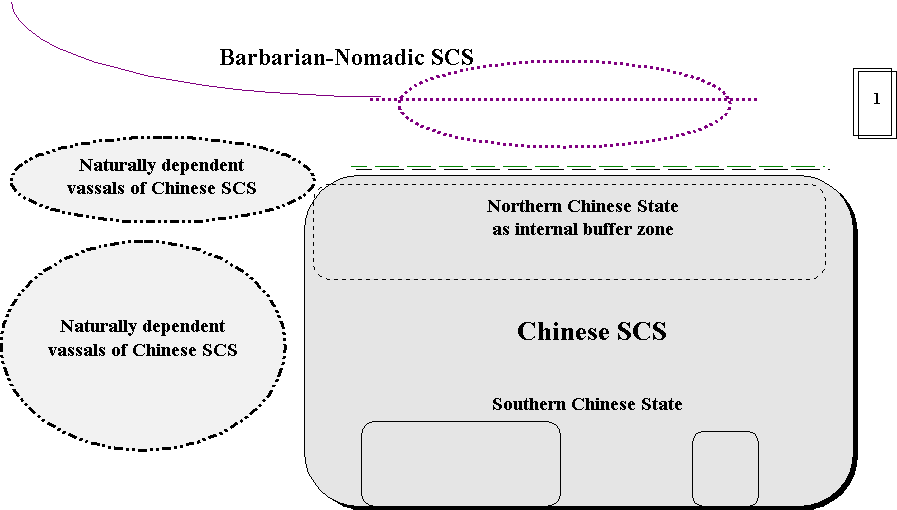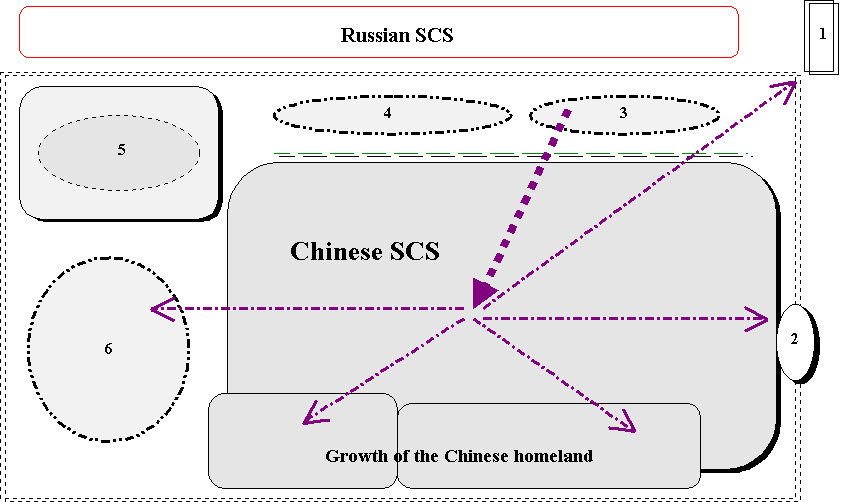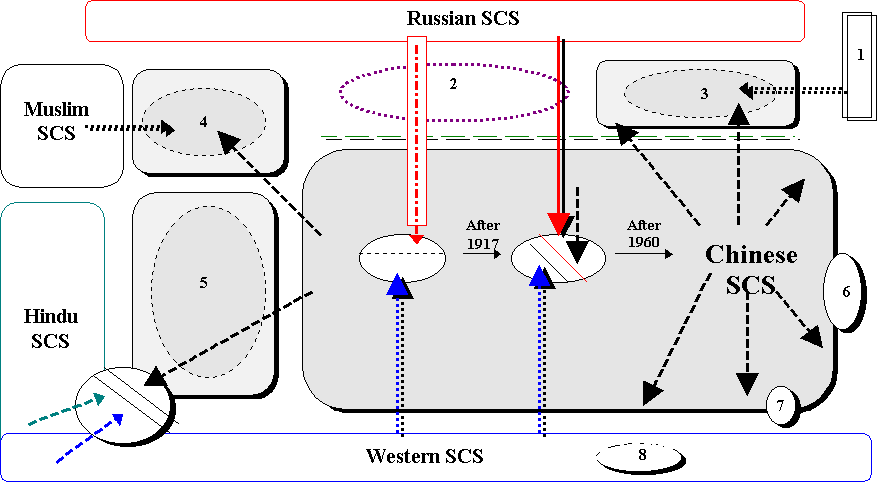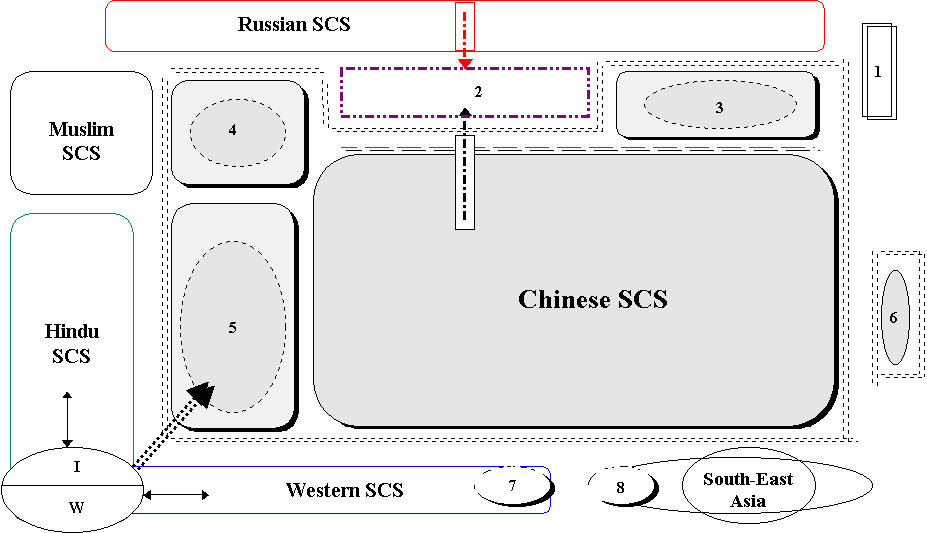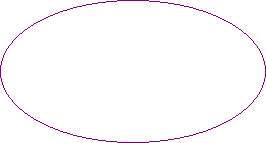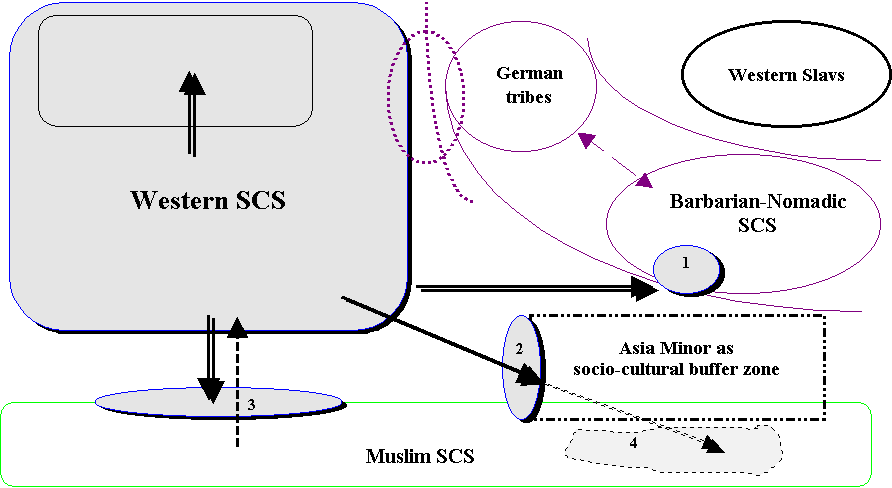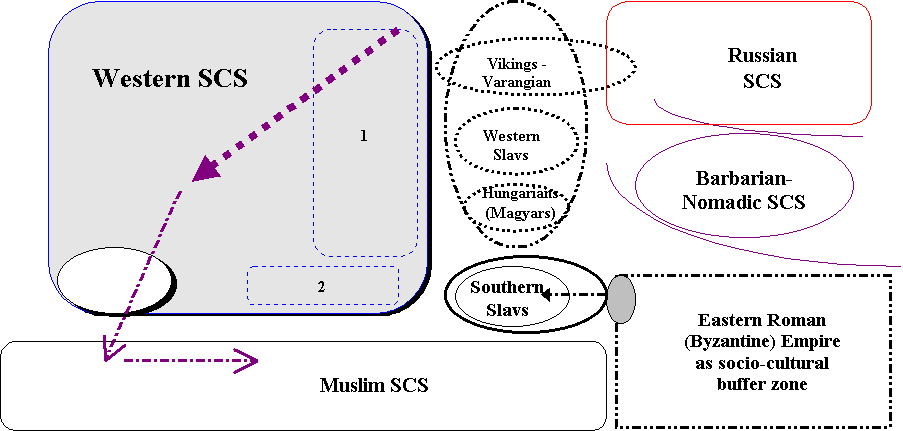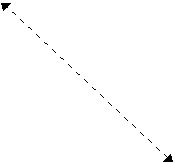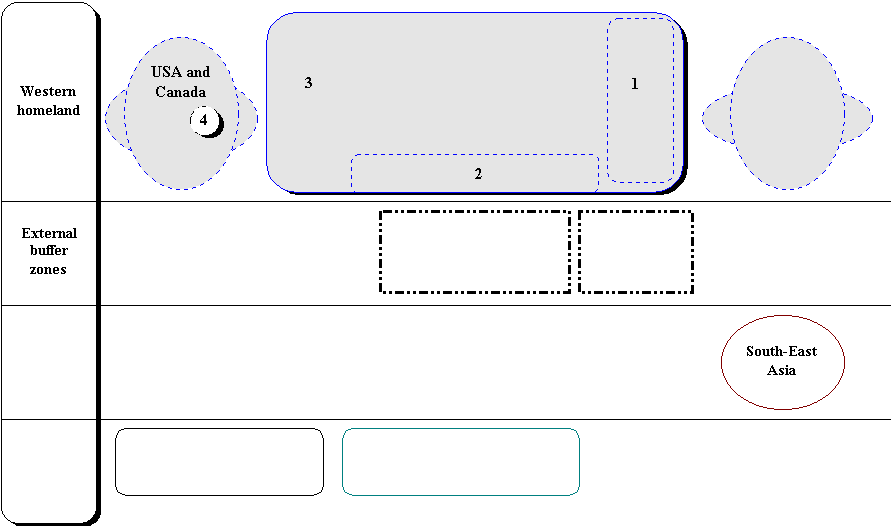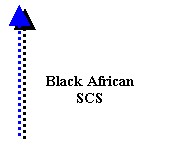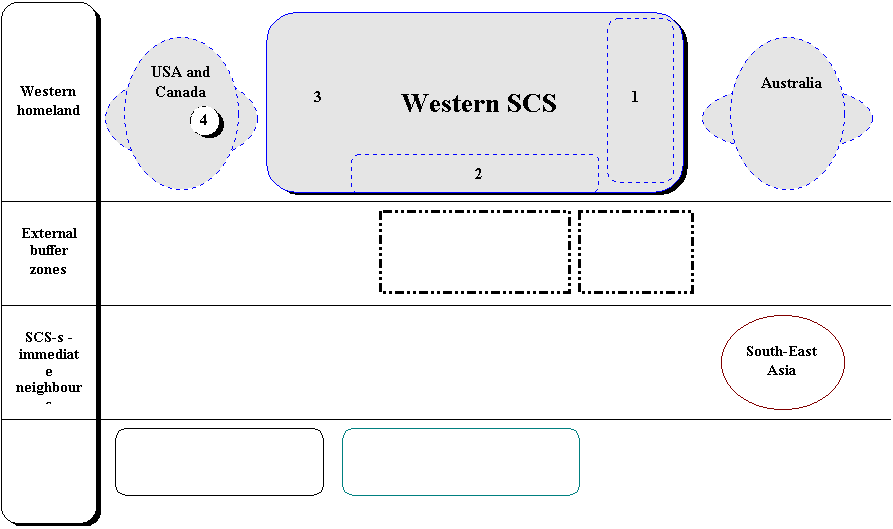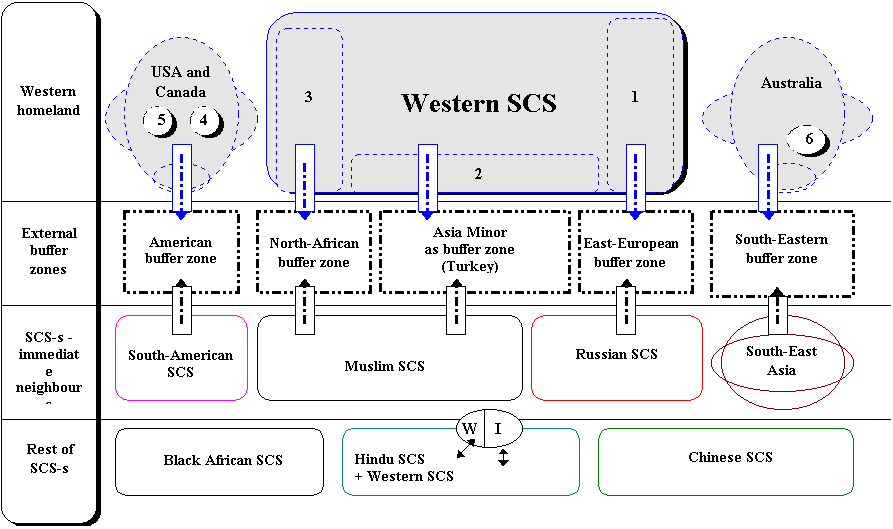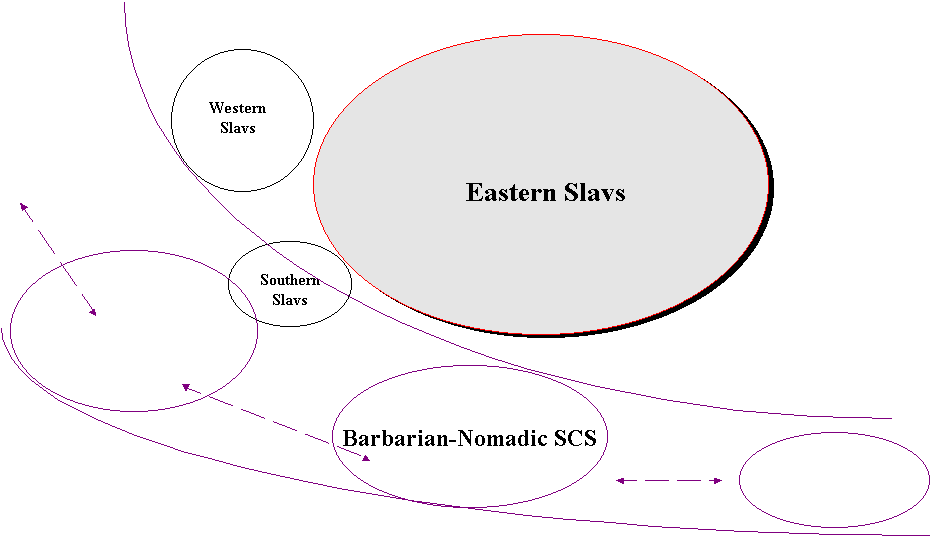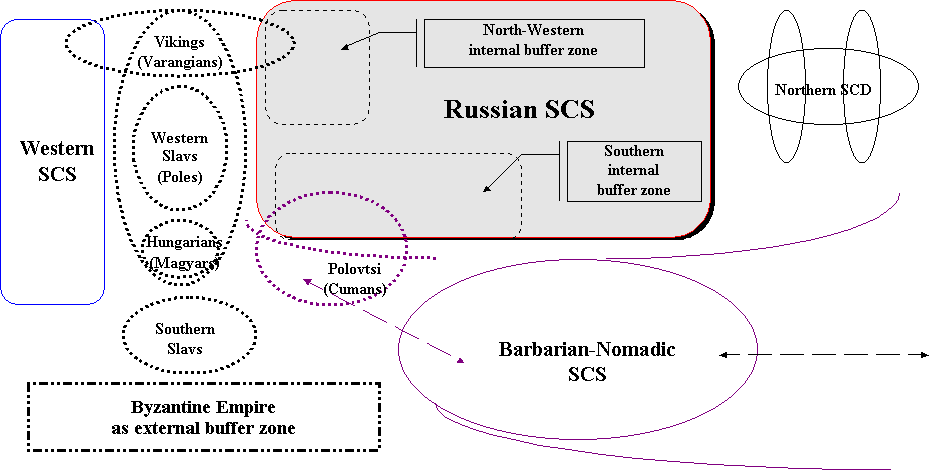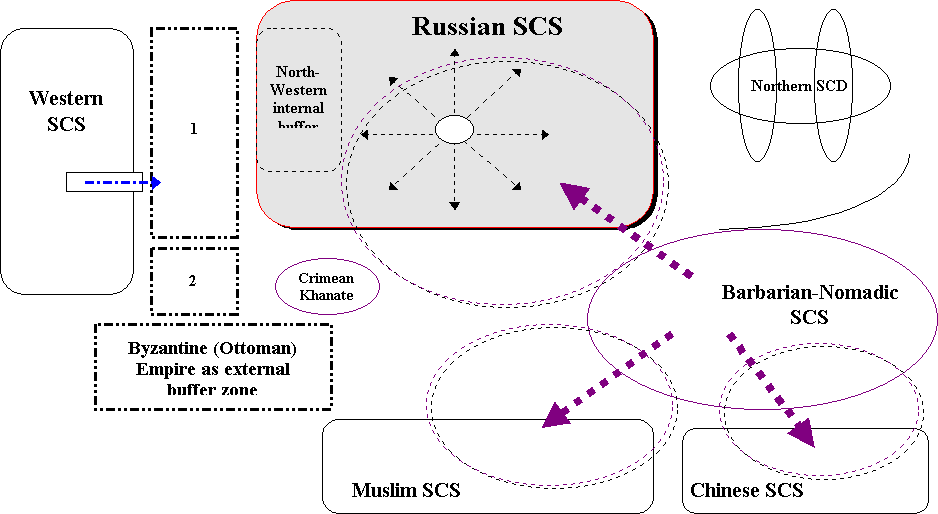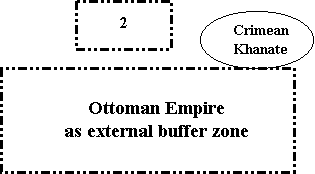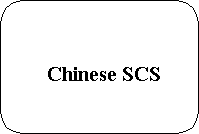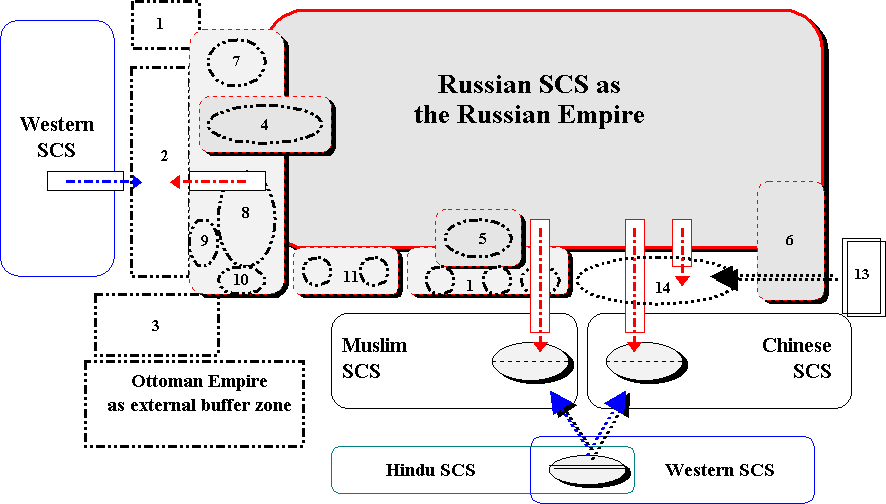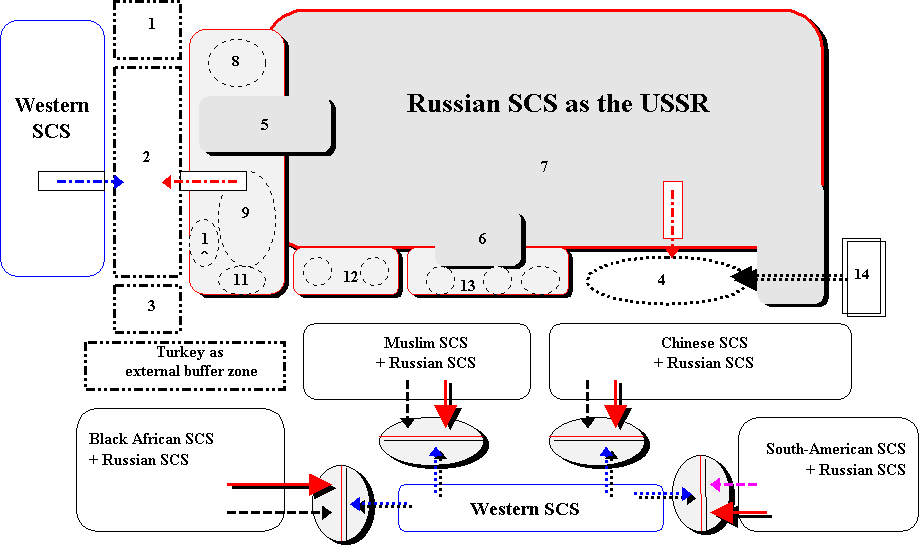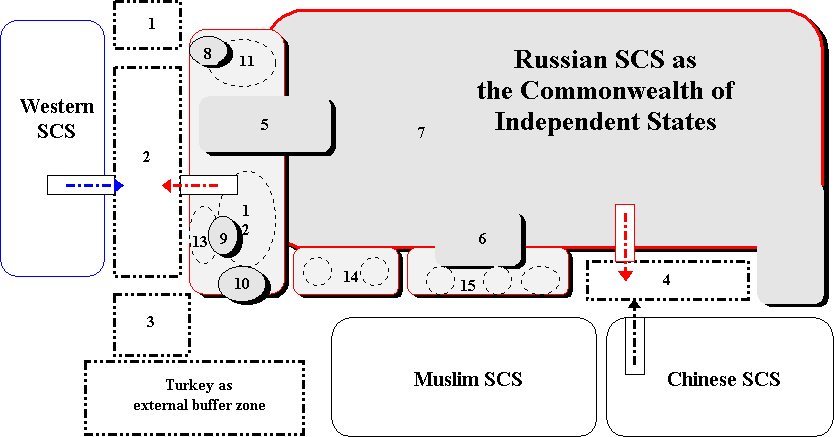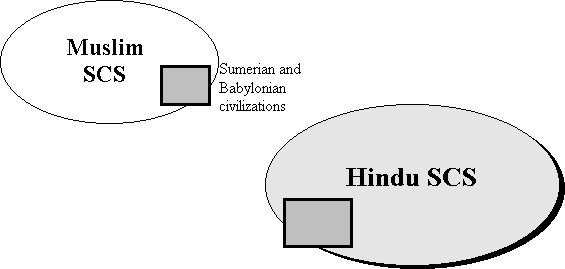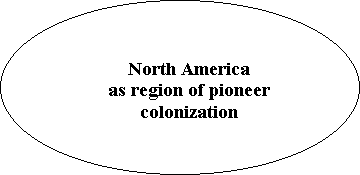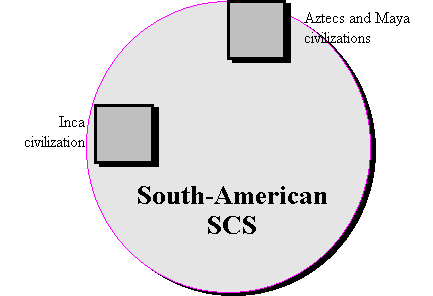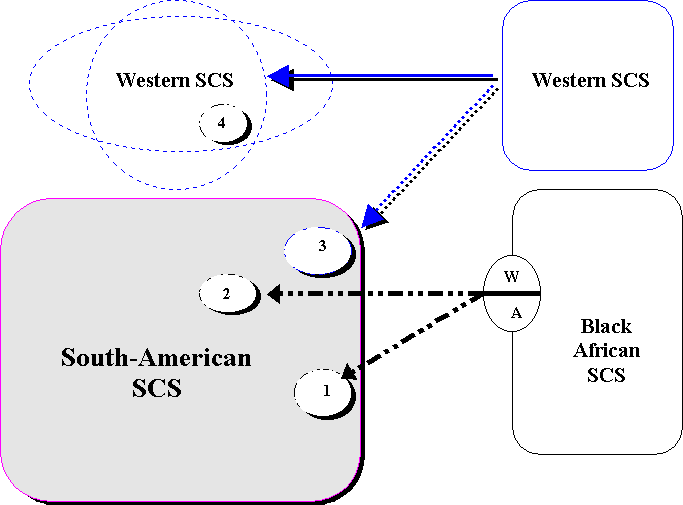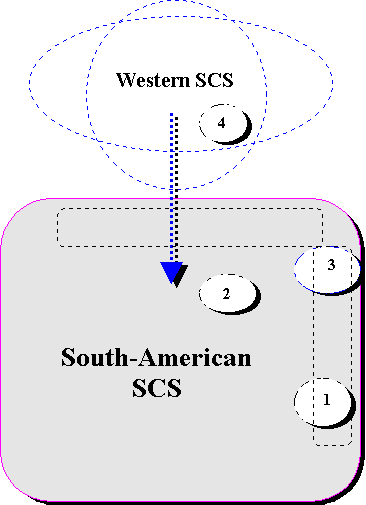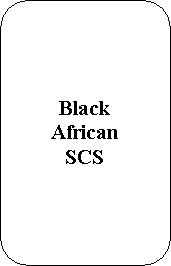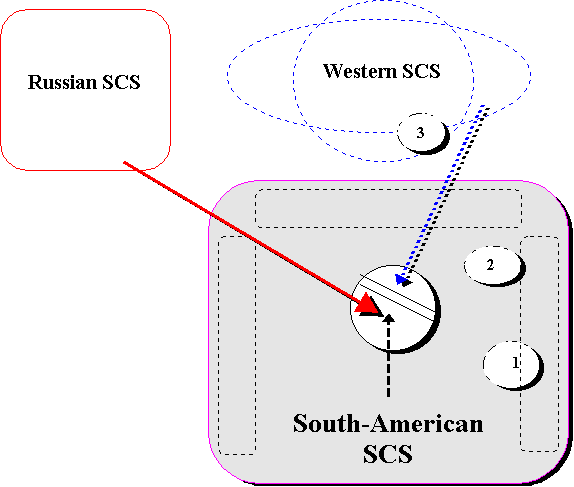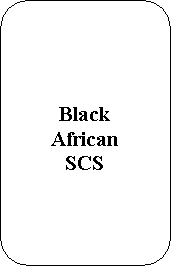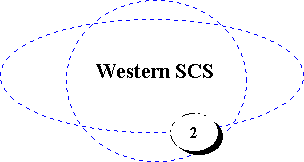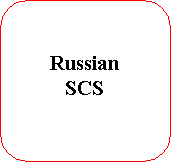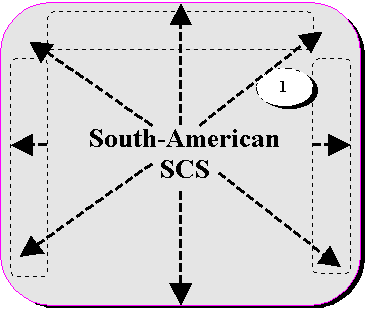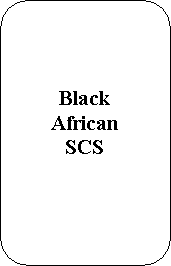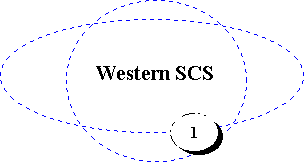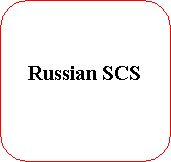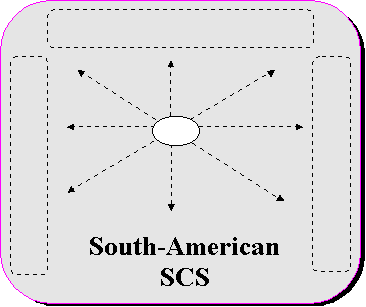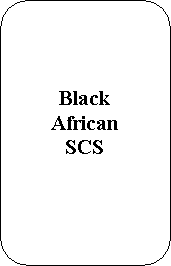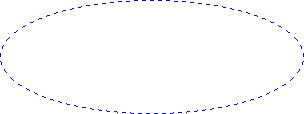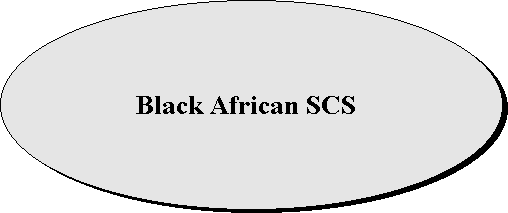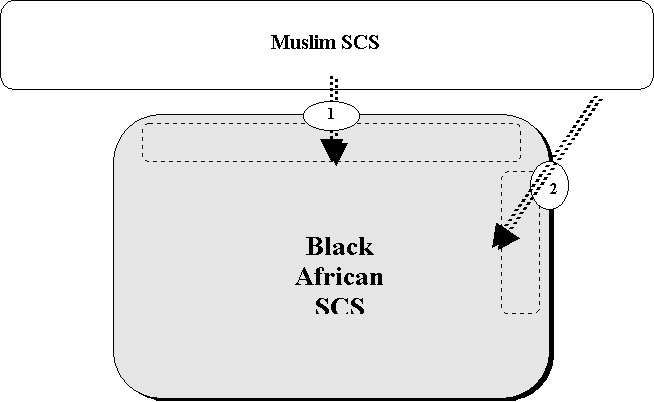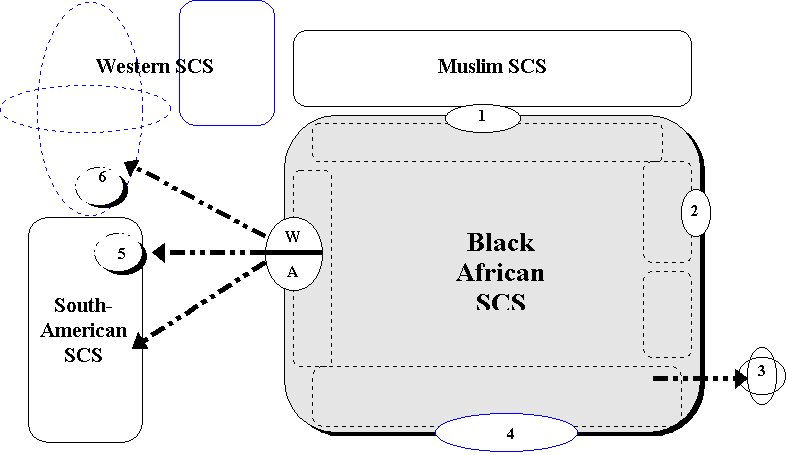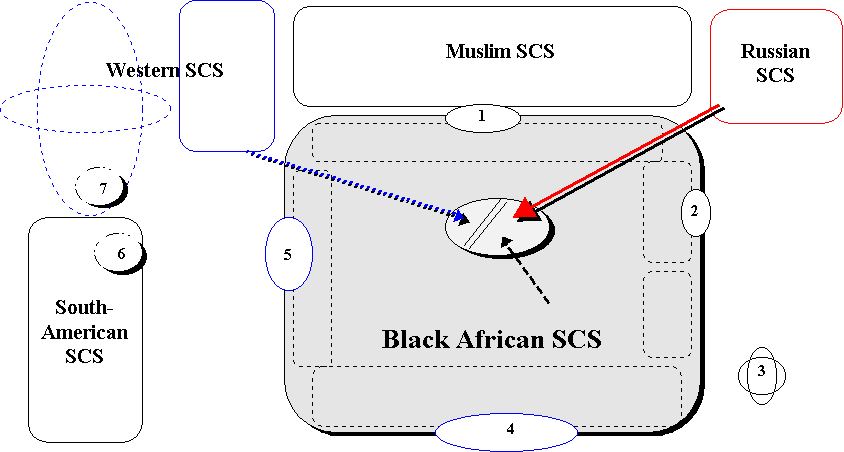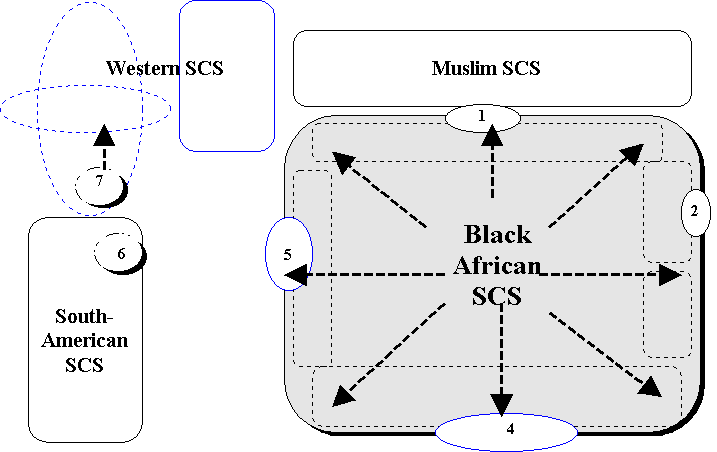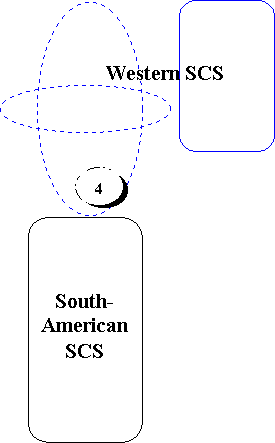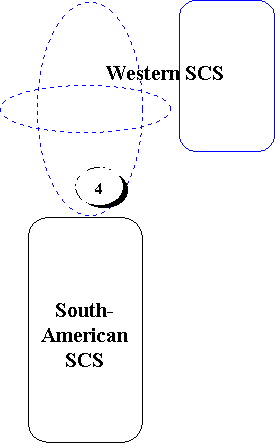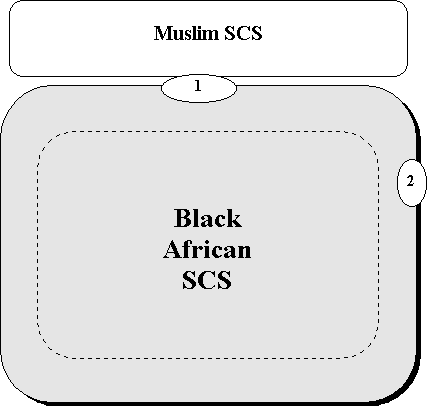Поиск по рефератам и авторским статьям
INTRODUCTION 153
1. THE TERMINOLOGY AND CONCEPTS USED:
DEFINITIONS 154
2. TYPES OF THE SOCIO-CULTURAL FORMATIONS 158
3. PERIODS OF THE SOCIO-CULTURAL SYSTEMS’ (SCS)
EVOLUTION 169
4. EVOLUTION OF THE SPACES OF THE SOCIO-CULTURAL
SYSTEMS: NUMERICAL SYMBOLS TO THE
TIME-SPATIAL MODELS 173
5. EVOLUTION OF THE SPACES OF THE SOCIO-CULTURAL
SYSTEMS: LEGEND TO THE TIME-SPATIAL MODELS 177
6. EVOLUTION OF THE SPACES OF THE SOCIO-CULTURAL
SYSTEMS: TIME-SPATIAL MODELS 180
6.1. BARBARIAN-NOMADIC SCS 180
6.2. MUSLIM SCS 187
6.3. CHINESE SCS 194
6.4. WESTERN SCS 201
6.5. RUSSIAN SCS 208
6.6. HINDU SCS 215
6.7. SOUTH-AMERICAN SCS 222
6.8. BLACK AFRICAN SCS 229
7. PERIODS AND SUBPERIODS OF THE
SOCIO-CULTURAL SYSTEMS EVOLUTION 236
| T |
his article is the first brief, but hopefully more or less systematical presentation of the theory of socio-cultural systems to an English-reading audience. It is actually the translation of the essay “Morphology of the Socio-Cultural Formations” written originally in Russian, but with some extras added to present here a more complete idea of the theory. Researches in this direction are conducted by the author since 1984, but not so many works were published until 1997. Those that were - fortunately or unfortunately - all are in Russian.
During these years the author lived and worked in several countries and regions of the World: in 1985/87 it was People’s Republic of China, in 1991/92 - Federal Republic of Germany, in 1992/93 - Republic of South Africa, in 1994 - the USA, and in 1995/97 - South Africa again. The result is real, personalized, not just read about observations of various socio-cultural types of spaces.
The work on the theory is going on. In 1998/99 we intend to make ready for publishing - in both Russian and English - texts on socio-cultural interpretations of demographic processes and current demographic situation in the World, state and political boundaries, wars and regional conflicts, economics and money, social processes in various socio-cultural systems. Some of these directions are explored in co-opearation with our loyal colleagues and co-authors, and Tatyana Nikolaenko in particular.
January 10th, 1998
Simferopol, Crimea
In this first small chapter we wish to define more precisely the principal terms used further. It’s always quite complicated procedure, but in this particular case we can do it quite correctly after describing indicative qualities of every main socio-cultural formation. We do not even hope to present here a completely exhaustive, maximum correct definitions, and in general don’t believe such “statements of a things’ precise meaning” make any particular sense. It seems more important to define certain theoretical basis that would make it possible to successively and exactly distinguish one socio-cultural formation or process from another, along the whole length of their historical evolution. Complexity of this task is that socio-cultural formations and processes have very long life terms and exist as an astonishing diversity of specific external forms. With it all, their essence remains one and the same. Variety of the socio-cultural formations’ and processes’ specific forms makes defining the terminology used here quite a practical problem.
HOMELAND - the most profoundly transformed in a socio-cultural respect territory where representatives of a certain socio-cultural formation lived and / or still live during historically prolonged interval of time, absolutely securing this territory as their own. Homeland’s territory is always furiously protected and defended from any outside invasions. Representatives of the alien socio-cultural formations may be present there only for a brief time and with many a restrictions that especially concerns homelands of socio-cultural systems.
Territories of the Urals and Moscow region may serve as the examples of the Russian homeland. They were assimilated in accordance with Russian standards and are clearly interpreted as Russian homeland, though duration of these territories’occupation by the Russian population differs essentially.
SOCIO-CULTURAL SYSTEM (SCS) - type of the socio-cultural formations dominating in a socio-cultural evolution. SCS-s include main part of the World’s population and inhabited territories. SCS-s are characterized by great sizes of their territories and considerable quantities of own population; they possess original standards of a space, society and state organisation as well as many a unique qualities because of those they do differ drastically from the rest of the socio-cultural formations.
Unique characteristics of SCS-s are as follows:
- ability to expand own homeland at the expense of socio-cultural assimilation of a new territories;
- ability to generate complicated structure of own space, with internal buffer zones, in order to protect and defend itself from other SCS-s;
- complete cycle of the space socio-cultural assimilation which includes seven principal stages;
- domination of the inner logics over outer factors which are always used in a strict correspondence with the SCS’ evolution internal order;
- ability to create naturally dependent vassals in a course of socio-cultural transformation of other territories;
- own world religion, or its own unique version;
- ability to widen a circulation of own language outside own homeland, and first of all - in the internal buffer zone and among the naturally dependent vassals;
- reliability and self-sufficiency of own economy;
- ability to generate and invent stable original economic standards and forms which may have no analogues outside a particular SCS.
There are eight SCS-s, and in the process of their evolution each of them goes through seven stages. With this, at every stage SCS-s acquire specific distinguished forms. Thus, there are 56 essentially different external forms of SCS-s to understand which we should base all the theoretical interpretations on a correct generalization of a very high level.
INTERNAL BUFFER ZONE OF SCS - qualitatively original and distinctive socio-cultural part of the SCS’s space that is always located on the “outskirts” of the SCS’s homeland, along its borders with other socio-cultural formations. Internal buffer zone is destined mainly to protect homeland of a particular SCS from immediate contacts with alien SCS-s and their possible aggression. It may border with an external socio-cultural buffer zone as well as an internal buffer zone of a neighbouring SCS. Organization of an internal buffer zone is characterized by many a distinctive qualities determined by the specific evolutionary process of the SCS this particular buffer zone belongs to.
Example of the internal buffer zone of the past is the territory of the Great Novgorod Principality which, during socio-cultural contest of Russian SCS of the XI - XVI centuries, protected Russian homeland from the invasions of Western SCS. Modern internal buffer zone of Russian SCS is formed by the new independent states rising after the collapse and transformation of the USSR. All of them, excluding Belarus and Kazakhstan, have formed internal buffer zone of Russian SCS, irrespective of their own wishes as well as - and especially - declarations.
NATURALLY DEPENDENT VASSAL - relatively integral territory with own population that retains some unprincipal differences from the neighbouring, dominating over it SCS, but became this SCS’ inalienable part as a result of prolonged and systematic socio-cultural transformation. It is important that sizes of states - naturally dependent vassals may vary essentially: the point isn’t size in itself, but a special socio-cultural type of these formations.
Naturally dependent vassals may possess a considerable amount of political and economic independence, have quite complicated, and at times conflicting, relationships with their dominants, being actually just a part of a dominating SCS.
In fact, they practically cannot change their socio-cultural status, and the point isn’t just separate, single economic or political actions, but socio-cultural measures that should be conducted successively during several centuries and (most probably) on the competing SCS’ own initiative. Only initiative or, especially, declaratory wishes of a naturally dependent vassal itself are never quite enough to change its socio-cultural status, and not a single example of a naturally dependent vassal really changing its status is known. Study of eight SCS-s along the whole length of their history demonstrates that if some territory was formed as a naturally dependent vassal of a certain SCS, then it remains as such forever.
Example of a naturally dependent vassals are modern, now politically independent states rising on the basis of the disintegrated former USSR. All of them, excluding only Belarus and Kazakhstan, are naturally dependent vassals of Russia.
EXTERNAL SOCIO-CULTURAL BUFFER ZONE - type of the socio-cultural formations that evolves to separate two or more alien SCS-s. As a rule, external buffer zones border not immediately with the SCS-s, but with their internal buffer zones completely controlled by their own SCS-s. External buffer zone as a special socio-cultural formation is characterized by extreme instability and dependence on dynamics of those SCS-s it separates.
East Europe may serve as the classic example of the external buffer zone, being a special type of the socio-cultural formation which separates Western and Russian SCS-s.
SOCIO-CULTURAL DOMAIN (SCD) - type of the socio-cultural formations that is quite similar to socio-cultural system, but possesses a substantial quantity of a principal distinctions. It’s characterized by stable and prolonged existence as well as specific economic, social and cultural forms. Fundamental differences compare to SCS are that SCD-s are categorically unable to assimilate and transform new territories into own homeland, expanding it with this, and create naturally dependent vassals: so, there is no systematic work with space as in case of a socio-cultural systems. The effect is a sort of socio-cultural conservation: SCD-s do not change / expand their own space and in general do not evolve in themselves during very prolonged periods; modern results of such phenomenon are quite modest sizes of their territories. Another essential SCD-s distinction from SCS-s manifests itself in their extraordinary situational behaviour.
At the present level of knowledge about socio-cultural formations and processes, there is no possibility to determine the reasons for emerging differences of socio-cultural systems and domains with respect to space, but it’s possible to describe all the details and components of these distinctions.
MIXED SOCIO-CULTURAL REGION - territory that has no distinct internal socio-cultural dominant and where various socio-cultural formations (SCS-s, SCD-s and buffer zones) co-exist. As a rule, these are regions of the young historical assimilation which, in some perspective, gain socio-cultural certainty, but with this may retain in their boundaries presence of a several socio-cultural formations. Most probable evolution of a mixed socio-cultural regions is into naturally dependent vassals and external buffer zones, and as a more rare case - into part of the homeland of some SCS.
ENCLAVE - territory of a historically temporary domination of a particular SCS within another socio-cultural formation. Genesis and evolution of enclaves are diverse and in many respects depend on a specific characteristics of a particular SCS’ dynamics. As a rule, enclaves are generated during process of expanding areas controlled by one or another SCS. They carry out important socio-cultural tasks, but are not lasting as from historical point of view. Next in turn stage of the SCS evolution may become the reason for enclave’s degradation, even in the absence of an external pressure.
ENCLAVE-COMMUNITY WITHIN ALIEN SCS - critical self-reproducible quantity of one SCS’ population permanently living on the territory of another SCS and retaining with this own specific socio-cultural standards. Enclave-community reproduces itself by means of both natural growth and mechanical migrations of population from maternal SCS into SCS of permanent inhabitance. Enclave-communities are most typical for the regions of mixed socio-cultural as well as pioneer inhabitance.
As the classical example we may consider black inhabitants of North America, and the USA in particular.
SOCIO-CULTURAL CONTEST - process which is inherent only for socio-cultural systems. Its socio-cultural meaning lies in developing and selecting the most efficient, in a specific historical conditions, socio-cultural basis for a certain SCS which should determine further ways of solving this SCS’ most fundamental and principal problems. Socio-cultural contests may take place at various stages of the SCS-s evolution and, as a rule, in a form of a cycle of civil wars, domestic quarrels and feuds, economic and cultural depression. They do usually leave the very gloomy and strange memories in the following generations and become the subject of subsequent falsifications from the side of their very own SCS-s. In reality, socio-cultural contests are absolutely necessary for the efficient growth and development of any SCS and are a kind of its response to changing arrangements of socio-cultural powers.
SOCIO-CULTURAL MIGRATIONS (SOCIO-CULTURALLY SIGNIFICANT MIGRATIONS) - migrations that are directed outside the traditional homeland of a certain SCS and aimed at the socio-cultural transformation of the alien territories into the new homeland of the SCS in question, or creating its naturally dependent vassals. Such migrations are the unique quality of SCS-s. Specific causes that bring them about may be very different, but, as a rule, manifest themselves through generating a sort of the “end of the World” within traditional homeland.
Example of the migrations aimed at the expanding the own homeland is eastward flight of Russians onto new territories in Siberia and Far East as from the second half of the XVI century, and especially - as from the second half of the XVII century. The result of the “time of troubles” within the traditional - at the time - Russian homeland and the Russian Orthodox church schism were mass migrations of the Russian population to new lands which thus became the new Russian homeland - not the result of a fortuitous, but socio-culturally grounded process.
Processes of the rise and growth of the Cossacks in Moscow Tsardom and Russian Empire as well as resettlements of a considerable numbers of Russians in Baltic Republics and Middle Asia during Soviet times may serve as the examples of the migrations aimed at the creating naturally dependent vassals. Results of such “melting” actions and processes began revealing themselves only after the USSR disintegration. Transformed in a socio-cultural respect territories turned out to be greatly dependent from Russia.
Such processes are of universal character and take place in the evolution of actually all the SCS-s - socio-cultural migrations are not unique for any one of them.
|
|
|
|
|
|
|
|
|
| Socio-cultural system (SCS) | Always possesses and controls significant territories |
| Socio-cultural domain (SCD) | Never comparable to the SCS’ space. As a rule, it’s much less than the territory of ane taken separately SCS, and may be quite insignificant |
| Socio-cultural buffer zone | Never comparable with the SCS’ space. As a rule, it’s much less than the territory of any taken separately SCS, and as the neighbouring socio-cultural systems progress, decreases to a certain modest size |
| Mixed socio-cultural region | May possess quite large initial area, but demonstrates persistent tendency to its gradual reduction, due to various parts of the territory assimilation into and by other socio-cultural formations - socio-cultural systems and domains |
|
|
|
| Socio-cultural system | Always has own homeland where significant part of its population lives continually |
| Socio-cultural domain | In accordance with this particular criterion, there are two types of socio-cultural domains: 1. Stable SCD with permanent homeland and permanent population; 2. Sporadic SCD, with homeland where its population may be absent for centuries |
| Socio-cultural buffer zone | Homeland exists, but it’s extremely changeable and unstable. Its fluctuations depend mainly on external factors, such as pressure from the neighbouring SCS-s side. Furthermore, homeland cannot be defined absolutely exactly within an entire area of enhabitance and control of this particular socio-cultural type’s population as a whole |
| Mixed socio-cultural region | Homeland has no definite, precise character. At the developed stage, micro-differences of the neighbouring socio-cultural enclaves’ homelands may take place. Representatives of the various socio-cultural systems and domains have own homelands within the mixed region |
|
|
|
| Socio-cultural system | Has the ability to assimilate the new territories into own homeland, as a rule, in regard to territories bordering with the old homeland and extended from its borders for any distance. This ability is the unique quality and indication of SCS |
| Socio-cultural domain | Has no such ability. Only temporary changes of the controlled space may take place. In practice, homeland never changes to grow |
| Socio-cultural buffer zone | Has no such ability. Homeland may hardly be defined from an entire area of permanent enhabitance of the particular socio-cultural buffer zone’s population and its temporary control. Homeland never grows as a result of new territories assimilation |
| Mixed socio-cultural region | Socio-cultural systems’ homelands expand to a considerable degree at the expense of transformation of the mixed socio-cultural regions’ spaces. Population of the mixed socio-cultural regions themselves does not reveal any tendencies to expand their homeland(-s) |
|
|
|
| Socio-cultural system | Has the ability to generate complicated internal structure of own space, mainly in order to protect and defend itself from other SCS-s and as a response to respective demands from the outside. This ability expresses itself in creating internal buffer zones along the borders with other SCS-s. This is the unique quality and indication of SCS |
| Socio-cultural domain | Has no ability to generate complicated internal structure of own space. It’s homogeneous because of its insignificant size and in the absence of systematic work with own space as well as neighbouring territories during historically considerable intervals of time |
| Socio-cultural buffer zone | Has no ability to generate complicated internal structure of own space. The latter is extremely unstable and changeable, and depends on outer factors, in particular, conditions and conflicts of the neighbouring SCS-s |
| Mixed socio-cultural region | Has no ability to generate complicated internal structure of own space. The latter is extremely unstable and changeable, and depends on outer factors, in particular, conditions and conflicts of the neighbouring SCS-s |
|
|
|
| Socio-cultural system | Does have such ability. At the early stages of evolution SCS-s may produce isolated civilizations. Later on, as SCS develops and evolves, it absorbs these civilizations into itself. Generating civilizations is a unique, but, none the less, not obligatory quality and indication of the SCS: it depends on a specific (regional) conditions of a historical process |
| Socio-cultural domain | Unable to generate civilizations. In spite of their whatever great age and antiquity, SCD-s do not invent such forms of the territories’ colonization / assimilation |
| Socio-cultural buffer zone | Unable to generate civilizations |
| Mixed socio-cultural region | Unable to generate civilizations |
|
|
|
| Socio-cultural system | Possesses the ability to independentrly generate one or several stable states. Number of states depends on a stage of the SCS evolution and may vary greatly (from one state occupying the whole SCS territory, and up to several dozens) |
| Socio-cultural domain | This ability manifests itself depending on the SCD’s type: 1. Stable SCD with stable population and stable homeland, as a rule, generates one stable state; 2. Sporadic SCD with homeland where its population may be absent for centuries, generates one state which however exists only from time to time |
| Socio-cultural buffer zone | Never independently generates stable states. Buffer states constantly change their boundaries and, in general, greatly vary in their sizes and configurations. Subject to (conflicting) interests and conditions of competing neighbouring SCS-s, they may be represented either by one or several states. Any buffer states are extremely unstable and always greatly depend on external factorsd (conditions and relations of neighbouring SCS-s, in particular) |
| Mixed socio-cultural region | Never independently generates stable states, though areas inhabited by certain population - but never states - may be quite stable. May have both one or several states as well as no states at all: everything depends on positions of SCS-s participating in the region’s assimilation, and the stage of evolution of the mixed region itself |
|
|
|
| Socio-cultural system | Usually possesses considerable reserves of vitally important natural resources. Their structure differs significantly and, of course, depends on previous geological history of the SCS territory, but in general available resources allow the SCS’ economy to exist, in practice, autonomously |
| Socio-cultural domain | SCD’s territory, as a rule, isn’t considerable in itself, and most often reserves of vitally important natural resources are not contained there. In case of Northern SCD, their independent exploitation is in fact impossible due to primitive level of this SCD’s general progress |
| Socio-cultural buffer zone | As a rule, there are no considerable reserves of vitally important natural resources within socio-cultural buffer zones. And if such resources are found, then unstable space of a buffer zone becomes an object for the next re-partition by competing neighbouring SCS-s, and buffer zone itself is again left without an important natural resource |
| Mixed socio-cultural region | Considerable reserves of vitally important natural resources may be found, but their exploitation is completely determined by various SCS-s participating in a mixed region’s assimilation, and is an external business for the particular mixed region itself |
|
|
|
| Socio-cultural system | Possesses the ability to generate ecological crises within local spaces during process of their assimilation, in order to move then further, onto new territories with better natural and living conditions - in order to generate ecological crises there afresh. Such is, as a matter of fact, strategy of an initial socio-cultural assimilation of territories within utmost possible limits. After the boundaries of the socio-culturally assimilated spaces are defined, ecological crises lose their socio-cultural meaning and are not generated any more |
| Socio-cultural domain | There is no such ability. SCD-s do not generate ecological crises as a step in a space assimilation, and are inserted into their natural environment with maximum correctness. The reason is not so much their highly-developed culture, but their inability to expand own socio-culturally assimilated space |
| Socio-cultural buffer zone | Socio-culturally oriented ecological crises may take place in a buffer zones, but they are never aimed to expand their own socio-cultural space and / or assimilate alien territories, and are results of periodic fluctuations of a buffer zone’s territory influenced by neighbouring SCS-s. The reason of such ecological crises may be, for instance, next in turn replacement of a dominating neighbouring SCS. Similar ecological crises are generated not by buffer zone itself, but by one of neighbouring SCS-s within a buffer zone’s space as a sort of socio-cultural provocation aimed to achieve certain purposes of a certain SCS |
| Mixed socio-cultural region | Socio-culturally oriented ecological crises may take place in a mixed regions, but they are never aimed to expand their own socio-cultural space and assimilate alien territories, and are results of periodic changes in the SCS-s’ power arrangements in the region. The reason of such ecological crisis may be, for instance, next in turn replacement of a dominant SCS |
|
|
|
|
|
|
| Socio-cultural system | Stable existence during historically significant intervals of time is a characteristic of SCS. Its life terms are amounted to 2500 years and more |
| Socio-cultural domain | Stable existence during historically significant intervals of time is also a characteristic of SCD-s. Their life terms are amounted to 2500 years and more, too |
| Socio-cultural buffer zone | Usually formed as a result of neighbouring SCS-s interaction and competition. As a rule, period of a buffer zone existence is lesser than any of the neighbouring SCS-s. Life term of the buffer zone as a specific socio-cultural formation may amount to 1000 years and more |
| Mixed socio-cultural region | Heavily depends on specific (historical) conditions of the region colonization. As a developed formations may exist for a very long while without any changes. Life term of a completely formed mixed socio-cultural region may amount to 2000 years and more |
|
|
|
| Socio-cultural system | Possesses a complete cycle of the space socio-cultural assimilation. Researches reveal seven principal stages of socio-cultural evolution, and every stage may consist of a few particular phases. This is the unique quality and indication of SCS |
| Socio-cultural domain | Has no such cycle. As distinguished from SCS, SCD does not work regularly at transforming its socio-cultural space. Its homeland is static during historically considerable periods. As a result of a favourable outside situation, SCD’s controlled space may change drastically, but always for a very brief time and without any socio-cultural assimilation / transformation of the territory that falls under such temporary control |
| Socio-cultural buffer zone | Has no complete cycle. Everything depends on the outside situation that determines the buffer zone’s behaviour. Buffer zone itself does not work regularly at expanding and transforming its socio-cultural space. As a result of a favourable outside situation, space controlled by particular buffer zone may change drastically, but always for a (historically) brief time and without any socio-cultural assimilation / transformation of the territory that falls under such temporary control |
| Mixed socio-cultural region | Has no complete cycle. Everything depends on the outside factors and situation that determine specific behaviour of the mixed socio-cultural region. It’s unable to work regularly at expanding and transforming its socio-cultural space at all |
|
|
|
|
|
|
| Socio-cultural system | Inner logics always prevail over outer factors which are only used in case of strict correspondence with the SCS’s evolution internal order. Even successful external spatial expansions are always used for the own inner purposes. This is the unique quality and indication of SCS |
| Socio-cultural domain | Does have some inner regularlities which may sometimes prevail over external factors, but in many cases namely outer factors prove to play decisive role in determining ways of the SCD’s evolution. Pressure from the outside does not usually lead to annihilation of the SCD’s socio-cultural specifics, but its resistance to the outside influences isn’t sufficient |
| Socio-cultural buffer zone | Internal logics do not play a significant role. Outer factors obviously dominate. Pressure from the neighbouring SCS-s side takes place nearly permanently and determines ways of the buffer zone evolution. Resistance to the outside influences is extremely low |
| Mixed socio-cultural region | Internal logics do not play a significant role. Outer factors obviously prevail. Correlation of the various SCS-s positions in the mixed socio-cultural region determines ways of its evolution. Resistance to the outside influences is extremely low |
|
|
|
| Socio-cultural system | Possesses the ability to create enclaves within alien regions to transform and assimlate them socio-culturally. This is the unique quality and indication of SCS |
| Socio-cultural domain | Has no such ability. May establish temporary enclaves only as a way of own diffusion, but never - for socio-cultural transformation and assimilation of alien territories |
| Socio-cultural buffer zone | Has no such ability. May establish temporary enclaves only as a way of own diffusion, but never - for socio-cultural transformation and assimilation of alien territories. Socio-cultural buffer zones themselves are often being assimilated into other socio-cultural formations |
| Mixed socio-cultural region | Has no such ability. Population of the mixed regions may create temporary enclaves only as a way of own diffusion, but never - for socio-cultural transformation and assimilation of alien territories, being themselves assimilated into other socio-cultural formations |
|
|
|
| Socio-cultural system | Able to create stable enclave-communities within alien socio-cultural formations |
| Socio-cultural domain | Able to create stable enclave-communities within alien socio-cultural formations |
| Socio-cultural buffer zone | Able to create temporary enclave-communities within alien socio-cultural formations during periods of escessive emigration, but with time these enclave-communities always become themselves assimilated into their foster socio-cultural formations |
| Mixed socio-cultural region | Able to create temporary enclave-communities within alien socio-cultural formations during periods of escessive emigration, but with time these enclave-communities always become themselves assimilated into their foster socio-cultural formations |
|
|
|
| Socio-cultural system | If necessary, may generate such vassals and colonies alike, usually established to decide certain internal problems connected with own socio-cultural evolution and transformation of other territories |
| Socio-cultural domain | In case of necessity and as a result of a certain, advantageous for them external situation, SCD-s with stable homelands may generate colonies and vassals, but only for a very brief time. However, this never leads to socio-cultural transformation of neither stable SCD-s themselves nor peoples and territories temporarily subordinate to them. Sporadic SCD-s never establish neither vassals nor colonies |
| Socio-cultural buffer zone | May generate colonies and vassals of a second grade, with this permanently being itself a vassal of a certain neighbouring SCS. Space temporarily controlled by the buffer zone states never exceedes the limits of internal and external buffer zones themselves. Changes of the controlled areas are absolutely unstable and always external matters for a buffer zone itself |
| Mixed socio-cultural region | Mixed socio-cultural region is usually itself colony and / or vassal of a certain SCS and subject to the various SCS-s struggle and socio-cultural competition |
|
|
|
| Socio-cultural system | Has the ability to create naturally dependent vassals in a course of socio-cultural transformation of other territories. This is the unique quality and indication of SCS |
| Socio-cultural domain | Has no such ability. Military-political and economic vassals of a second grade never become naturally dependent ones. SCD-s themselves may, for a certain historical time, become vassals of a neighbouring SCS and then use such subordinate status to achieve own goals and gain some socio-cultural benefits |
| Socio-cultural buffer zone | Has no such ability. Buffer zones never form naturally dependent vassals and themselves are always vassals of a neighbouring SCS. Change of a dominating SCS is a routine and always external matter |
| Mixed socio-cultural region | Has no such ability. Mixed socio-cultural regions never form naturally dependent vassals and themselves are always vassals of various SCS-s which pretend to assimilate some territories within the region. Change of a dominating SCS is a routine and always external matter |
|
|
|
|
|
|
| Socio-cultural system | Quantities of the SCS population, compare to general numbers of currently inhabiting the Earth people, are always significant. Most of the World’s population lives within SCS-s |
| Socio-cultural domain | Quantities of the SCD-s population, as a rule, are not comparable to those of SCS-s, but may be quite significant, especially in the case of SCD-s with stable homelands |
| Socio-cultural buffer zone | Quantity of the buffer zone population may be quite large, but, as a rule, it’s never comparable to that of any taken separately SCS. It maintains definite tendency to periodically reduce the numbers of own population, at the expense of various mechanical migrations of its considerable parts |
| Mixed socio-cultural region | Quantity of the mixed region population may be quite large, but, as a rule, it’s not comparable to that of SCS |
|
|
|
| Socio-cultural system | Able to socio-culturally assimilate alien population successively. This ability manifests itself during periods of creating the own homeland and internal buffer zones. This is the unique quality and indication of SCS |
| Socio-cultural domain | Has no such ability. SCD’s population is rigidly reserved and unable to assimilate alien population in principle. Isolation from the rest of the world is a strict standard of SCD as a specific socio-cultural formation |
| Socio-cultural buffer zone | Has no such ability. There is no isolation as in case of SCD, but there is no assimilation of alien population either |
| Mixed socio-cultural region | Within mixed socio-cultural regions, assimilation of alien population and territories by various SCS-s takes place. At the developed stages of a mixed region assimilation, it ceases |
|
|
|
| Socio-cultural system | SCS’s population is able to preserve its specific qualities within alien socio-cultural formations |
| Socio-cultural domain | SCD’s population possesses strikingly expressed ability to retain own specific qualities within alien socio-cultural formations. It guarantees SCD’s survival in a sporadic condition during historically considerable intervals of time |
| Socio-cultural buffer zone | Such ability isn’t quite obvious. Usually, assimilation of the significant parts of a buffer zone’s population into other socio-cultural formations takes place |
| Mixed socio-cultural region | Population is too diverse and heterogeneous. As a rule, it retains own qualitative characteristics, but also may be assimilated itself: everything depends on a combination of specific (historical) conditions |
|
|
|
| Socio-cultural system | Population has homogeneous socio-cultural character. There are certain stages of its socio-cultural assimilation. There is also definite distinction between population of such types of the socio-cultural spaces as homeland, internal buffer zones and enclaves. Exceptions may appear within population inhabiting recently included into SCS territories. Existence of such non-converted (non-transformed) socio-culturally population and its territories within SCS is usually temporary and ends in a complete socio-cultural assimilation. Growth of the SCS population is attributed to natural increase as well as assimilation of new territories with all their population, with the latter’s successive conversion and transformation that may last for centuries |
| Socio-cultural domain | Population has homogeneous socio-cultural character and differs drastically from the rest of the world. SCD’s basic distinction from SCS is that growth of the SCD population is attributed to its natural encrease only, and never - to socio-cultural conversion and assimilation of other territories with their population |
| Socio-cultural buffer zone | As a rule, population isn’t socio-culturally homogeneous. Depending on a specific historical situation, very different versions and combinations of the population socio-cultural structure may take place |
| Mixed socio-cultural region | As a rule, population isn’t homogeneous. Depending on a specific historical situation, very different versions and combinations of the population socio-cultural structure may occur |
|
|
|
| Socio-cultural system | Possesses such ability. SCS-s generate migrations of population to socio-culturally transform alien territories into homelands, naturally dependent vassals and enclaves within internal buffer zones. In all the SCS-s, such migrations most often happen as a result of creating “end of the World” (mass starvation, civil wars, unstable state authorities) within traditional homelands. This is the unique quality and indication of SCS |
| Socio-cultural domain | Has no such ability |
| Socio-cultural buffer zone | Has no such ability |
| Mixed socio-cultural region | Has no such ability |
|
|
|
| Socio-cultural system | Has no such ability. SCS-s do never possess too big numbers of population so that to force it out into new territories without historically clear and definite purposes of their socio-cultural transformation |
| Socio-cultural domain | Such ability can be traced. SCD-s representatives may diffuse into various SCS-s and be present there to solve own problems, but never - to transform and assimilate other territories socio-culturally |
| Socio-cultural buffer zone | Such ability can be traced. Mass migrations of the buffer zone’s population into alien socio-cultural formations, and especially - into SCS-s, are possible from time to time and even quite regularly. Such migrations become a norm during aggravation of a neighbouring SCS-s competition to control some particular buffer zone, and may be well provoked by these SCS-s. However, migrations from buffer zones never aim to transform and assimilate other territories socio-culturally |
| Mixed socio-cultural region | Such ability exists. Mass migrations of the mixed region’s population into alien socio-cultural formations, and especially - into SCS-s, are quite possible from time to time. Such migrations become a norm during aggravation of relations of the SCS-s that participate in a competition to control some particular mixed region, and may be well provoked by these SCS-s. Migrations from mixed regions never aim to transform and assimilate other territories socio-culturally |
|
|
|
| Socio-cultural system | Possesses such ability. Can maintain whatever multinational structure of population and large numbers of languages, even representing different lingual groups. Unity and integrity of the SCS spaces is determined by their respective assimilation. National and lingual diversity do not have an influence on SCS in principle. In this respect SCS-s may demonstrate staggering tolerance which grows substantially after completing the socio-cultural transformation of the respective territories |
| Socio-cultural domain | Has no such ability. Within own homeland, consistent intolerance to different nationalities and their suppression develop. In case of SCD with own stable homeland, mononational structure of population and singular language usually take place |
| Socio-cultural buffer zone | Has a multinational structure of population and big numbers of languages which are foreign relatively one another. They are united only by the neighbouring SCS-s pressure which affects all the people of a buffer zone. This pressure may be reflected differently on a certain nations that naturally gives rise to inner problems whithin the buffer zone’s population |
| Mixed socio-cultural region | Has a multinational structure of population and big numbers of languages which are foreign relatively one another. They are united only by the fact that pressure of the competing for the region SCS-s affects all its people. This pressure may be reflected differently on a certain nations that naturally gives rise to inner problems whithin the mixed region’s population |
|
|
|
|
|
|
| Socio-cultural system | Always possesses own world religion or its own unique version. This is the unique quality and indication of SCS |
| Socio-cultural domain | Has no own world religion. SCD’s religions may be of a national character only and are bound to this particular SCD at most |
| Socio-cultural buffer zone | Has no own world religion. Some version of the neighbouring SCS’s religion always dominates. Choice of the religion has specific historical and often sircumstantial character, and is completely determined by correlation of the neighbouring SCS-s positions in the area |
| Mixed socio-cultural region | Various world religions may co-exist there, with no obvious dominance of any one. Structure of religions represented in the region is determined in many respects by external factors |
|
|
|
| Socio-cultural system | Possesses such ability. This is the unique quality and indication of SCS: it promotes own version of religion in a process of assimilation of alien territories and population |
| Socio-cultural domain | Has no such ability |
| Socio-cultural buffer zone | Has no such ability |
| Mixed socio-cultural region | Has no such ability |
|
|
|
| Socio-cultural system | Within lingual diversity, one or a few languages obviously dominate. There may also exist substantial number of stable languages of limited circulation. Language isn’t an absolute indicative distinction of the particular SCS from the rest of the socio-cultural formations. SCS’s dominant language may widen its circulation quite independently from the SCS itself |
| Socio-cultural domain | There is always one clearly dominant language which serves as a basis for singling out this particular socio-cultural formation from the rest of the world. This is an absolute indicative distinction of SCD-s from the rest of the socio-cultural formations |
| Socio-cultural buffer zone | Essence of this socio-cultural formation is such that considerable number of languages always co-exist there, in a proportion that is characteristic for population of some particular buffer zone. There are no and cannot be whatever dominant languages |
| Mixed socio-cultural region | Essence of this socio-cultural formation is such that considerable number of languages always co-exist there, in a proportion that is characteristic for population of some particular mixed region. There are no and cannot be whatever dominant languages |
|
|
|
| Socio-cultural system | Able to widen a circulation of own language outside own homeland, and first of all - in the internal buffer zone and among the naturally dependent vassals. Such language begins being used as a daily means of communications that is an important element of the process of socio-cultural assimilation of territories and population. This is the unique quality and indication of SCS |
| Socio-cultural domain | Has no such ability. Language is a unique attribute of the particular SCD’s population and is diffused only together with its bearers. Population of other socio-cultural formations never use this language as a means of daily communications |
| Socio-cultural buffer zone | Has no such ability. Diffusion of a language(-s) may only accompany migrations of a buffer zone’s population which, however, easily adopts language(-s) of either a more attractive or dominant SCS |
| Mixed socio-cultural region | Has no such ability. Diffusion of a language(-s) may only accompany migrations of a mixed region’s population which, however, easily adopts language(-s) of either a more attractive or dominant SCS |
|
|
|
|
|
|
| Socio-cultural system | Economy is reliable and self-sufficient. It possesses considerable internal reserves, and contacts with other socio-cultural formations do not play determining role in its development, though these contacts are important for sovling internal socio-cultural problems such as the neighbouring territories’ transformation and competition with alien SCS-s. This is the unique quality and indication of SCS |
| Socio-cultural domain | Economy is extremely vulnerable and never self-sufficient; in case of isolation becomes obviously poor and mediocre. Contacts with other socio-cultural formations are of most importance for economic prosperity and desired stability which, however, are never achieved |
| Socio-cultural buffer zone | Economy is extremely vulnerable and never self-sufficient. It depends mainly on neighbouring SCS-s which may both arrange for a periodic destruction in a buffer zone and assist its short-term prosperity if it conforms to their interests |
| Mixed socio-cultural region | Economy is extremely dependent on SCS-s that pretend to control the mixed region. In certain conditions of isolation, it may become self-sufficient (at the level of poverty and mediocrity) |
|
|
|
| Socio-cultural system | Possesses the ability to generate and invent stable original economic standards and forms which may have no analogues outside this particular SCS. This is the unique quality and indication of SCS |
| Socio-cultural domain | Able to generate and invent original economic standards and forms, however, quite unstable and aimed only to withstand the competing SCS-s pressure |
| Socio-cultural buffer zone | Has no such ability |
| Mixed socio-cultural region | Has no such ability |
|
|
|
| Socio-cultural system | Possesses the ability to generate and invent technological innovations for solving own socio-cultural problems, and first of all - internal tasks of creating the own homeland and naturally dependent vassals |
| Socio-cultural domain | Possesses the ability to generate technological innovations for solving own socio-cultural problems. However, invention of these innovations is always very limited and vulnerable due to the nature of this particular socio-cultural formations. Internal market is too small and in itself actually doesn’t need such innovations. Technological innovations are never associated with or caused by the socio-cultural tasks of space transformation |
| Socio-cultural buffer zone | Has no such ability |
| Mixed socio-cultural region | Has no such ability |
|
|
|
| Socio-cultural system | Possesses the potential ability and practical possibilities to conduct wide-scale economic sabotage actions directed against alien socio-cultural formations. Such actions may be brought about through various specific forms |
| Socio-cultural domain | Possesses the potential ability and practical possibilities to conduct economic sabotage actions aimed against other socio-cultural formations. These actions may be brought about in a various specific forms. Characteristically, scales of such activity are considerably smaller compare to those of SCS-s |
| Socio-cultural buffer zone | Has no such ability as well as possibilities |
| Mixed socio-cultural region | Has no such ability as well as possibilities |
Below, once more, is the list of the unique qualities and indications of socio-cultural systems:
|
|
|
| 1. | Has the ability to assimilate the new territories into own homeland, as a rule, in regard to territories bordering with the old homeland and extended from its borders for any distance |
| 2. | Has the ability to generate complicated internal structure of own space, mainly in order to protect and defend itself from other SCS-s and as a response to respective demands from the outside. This ability expresses itself in creating internal buffer zones along the borders with other SCS-s |
| 3. | Possesses a complete cycle of the space socio-cultural assimilation. Researches reveal seven principal stages of socio-cultural evolution, and every stage may consist of a few particular phases |
| 4. | Inner logics always prevail over outer factors which are only used in case of strict correspondence with the SCS’s evolution internal order. Even successful external spatial expansions are always used for the own inner purposes |
| 5. | Possesses the ability to create enclaves within alien regions to transform and assimlate them socio-culturally |
| 6. | Has the ability to create naturally dependent vassals in a course of socio-cultural transformation of other territories |
| 7. | Able to conduct successive socio-cultural assimilation of alien population, by including it into own structure together with the new territories. This ability manifests itself during periods of creating the own homeland and internal buffer zones |
| 8. | Possesses the ability to generate migrations of population to socio-culturally transform alien territories into homelands, naturally dependent vassals and enclaves within internal buffer zones. In all the SCS-s, such migrations most often happen as a result of creating “end of the World” (mass starvation, civil wars, unstable state authorities) within traditional homelands |
| 9. | Always possesses own world religion or its own unique version |
| 10. | Able to propagate and diffuse own version of religion outside own socio-cultural formation for transformation of other territories. This is the unique quality and indication of SCS: it promotes own version of religion in a process of assimilation of alien territories and population |
| 11. | Able to widen a circulation of own language outside own homeland, and first of all - in the internal buffer zone and among the naturally dependent vassals. Such language begins being used as a daily means of communications that is an important element of the process of socio-cultural assimilation of territories and population |
| 12. | Economy is reliable and self-sufficient. It possesses considerable internal reserves, and contacts with other socio-cultural formations do not play determining role in its development, though these contacts are important for sovling internal socio-cultural problems such as the neighbouring territories’ transformation and competition with alien SCS-s |
| 13. | Possesses the ability to generate and invent stable original economic standards and forms which may have no analogues outside this particular SCS |
Here is the list of the socio-cultural formations existing by the end of the XX century. They went through some evolution and are now at the different stages of their development. Morphology of the socio-cultural formations is described in detail by their time-spatial models.
Socio-cultural systems: Barbarian-Nomadic SCS, Black African SCS, Chinese SCS, Hindu SCS, Muslim SCS, Russian SCS, South-American SCS, Western SCS
Socio-cultural domains: Japanese SCD, Judaic SCD, Northern SCD
Socio-cultural buffer zones
We’re talking here only about external socio-cultural buffer zones located between different SCS-s. External socio-cultural buffer zones are at present at the various stages of their evolution and differ drastically one from another. None the less, they are clearly defined as the formations of a specific socio-cultural type.
Let’s cut the vast list of external buffer zones down to just two examples so that do not go deep into extensive explanations regarding complicated structures of these complex socio-cultural formations: 1. East-European buffer zone (Poland, Czechia, Slovakia, Hungary, Romania, Bulgaria). 2. North-European buffer zone (Finland, Sweden, Norway)
Mixed socio-cultural regions: Islands of Pacific and Indian Oceans, Israel and Palestine, South-East Asia
1. Initial period of the Barbarian-Nomadic SCS existence, surrounded by neighbours not internally ready to integrate with it socio-culturally (from ansient times until I century AD)
2. Establishing the buffer zone with Western SCS (I century - end of the IV century AD)
3. Socio-cultural integration of Barbarian-Nomadic and Western SCS. Rise of the renewed Western SCS (end of the IV century - second half of the VII century AD)
4. Creating the buffer zones between Barbarian-Nomadic SCS and all of its neighbouring SCS-s (from second half of the VII century until late XII century)
5. Socio-cultural integration of Barbarian-Nomadic SCS with all the neighbouring, accessible to it SCS-s. Socio-cultural assimilation of the
Barbarian-Nomadic SCS territory and population into these SCS  (late XII - 1380-s)
(late XII - 1380-s)
6. Rise of the Barbarian-Nomadic SCS residual homeland and population. Conflict of various neighbouring SCS-s for its socio-cultural assimilation, with the Barbarian-Nomadic SCS itself marionette participation in the process (late XIV century - middle of the XX century)
7. Establishing the Barbarian-Nomadic SCS residual homeland and population on the borders of Russian and Chinese SCS-s as their external buffer zone (from the second half of the XX century and for some future)
1. Initial sporadic colonization of the homeland territory in the most ancient civilizations and unknown old centres of inhabitance (XXX - VII centuries BC)
2. Initial spatial defining of the Muslim SCS territory and its early acquisition in the form of Empires. Conflict with Western SCS of its second stage for buffer spaces (750-s - 330-s BC)
3. Socio-cultural contest of Muslim SCS. Creating the internal buffer zones on borders with Western SCS. Assimilation of the other socio-cultural systems’ population within the Muslim territories (from 330-s BC until early VII century AD)
4. Islam as the product of the socio-cultural contest; unification of the Muslim territories based on Islam. Beginning of the Muslim controlled spaces growth, and establishing the buffer zones between Muslim SCS and all of its neighbouring SCS-s (Western, Barbarian-Nomadic, Hindu and Black African) (early VII century - 1258)
5. Socio-cultural integration with Barbarian-Nomadic SCS. Further growth of the Muslim controlled spaces into the territories of Black African and Hindu SCS-s. Creating the military-political vassals and buffer zones with all the neighbouring SCS-s (1258 - early XVIII century)
6. Conflict for buffer spaces with various SCS-s. Loss of the military-political vassals and the alien socio-cultural systems’ permanent presence in the Muslim homeland. Diffusion of the Muslim communities outside the Muslim homeland (early XVIII century - 1970-s)
7. Liberation of the Muslim homeland and its internal buffer zones from the alien socio-cultural systems’ permanent presence. Political-geographical transformation of the Muslim SCS space based on its own socio-cultural standards. Conflict with other SCS-s for the external buffer zones (from 1970-s and for some future)
1. Initial period of the Chinese population existence and Chinese SCS creation (from legendary Hsia Dynasty 1800 - 1500 BC to Eastern Chou Dynasty 770 BC)
2. Socio-cultural contest for creating the most efficient socio-cultural standard for Chinese SCS (from 770 to 221 BC - Eastern Chou Dynasty)
3. Unification of the Chinese SCS territory based on the chosen socio-cultural standard. Beginning of the homeland growth and establishing the naturally dependent vassals (221 BC - 317 AD)
4. Creating the internal buffer zone on the North, new naturally dependent vassals on the West and new homeland on the South (317 - 1211 AD)
5. Socio-cultural integration with Barbarian-Nomadic SCS. Creating the internal buffer zones, naturally dependent vassals and homeland growth on the South. Unification of the socio-culturally transformed territories into the united state (from 1211 until 1840-s)
6. Defining the buffer zones’ territories through conflict with various SCS-s. Military, political and economic presence of alien socio-cultural systems in the Chinese homeland. Beginning of the Chinese population intensive diffusion around the World (from 1840-s until the Great Cultural Revolution)
7. Creating the integral internal buffer zone and liberation of the Chinese homeland from the alien socio-cultural systems’ presence. Establishing the Chinese enclave-communities within Western SCS and the mixed socio-cultural regions (as from the end of the Great Cultural Revolution and for some future)
1. Initial period of the Western population existence and Western SCS creation. Initial sporadic colonozation of the homeland territory in the most ancient civilizations (from ancient times until 770 - 750-s BC)
2. Greek-Roman times. Western homeland growth. Rise of the first Empires and Greek-Roman communities outside the homeland. Establishing the buffer zone with Barbarian-Nomadic SCS (770 - 750-s BC - 380-s AD)
3. Socio-cultural integration with Barbarian-Nomadic SCS. Transformation and further expansion of the homeland. Creating internal buffer zones. Defining the new ideological grounds of Western SCS, based on Roman Catholicism (from 380-s AD until the Crusades beginning)
4. Socio-cultural contest of Western SCS. Transformation of the Pyrenees Muslim enclave into internal buffer zone. Creating naturally dependent vassals in the East-European buffer zone. Expansion outside own homeland into the mixed socio-cultural regions (from the Crusades beginning until the discovery of America)
5. Global overseas colonial expansion of Western national states. Growth of the homeland in the mixed socio-cultural regions with Western predominance (1490-s - 1918)
6. Global war against other socio-cultural systems headed by Russian SCS. Losing the control over colonies. Reversion of Western population into own homeland and its redistribution between the mixed socio-cultural regions with Western predominance and traditional Western territories (1918 - 1990-s)
7. Transformation of the European homeland and stimulating further population redistribution between the territories of old homeland and mixed socio-cultural regions with Western predominance. Creating the American and South-Eastern internal and external buffer zones (from 1990-s and for some future)
1. Initial period of the Slavonic world existence, with undeveloped socio-cultural differences (from ancient times until 882 AD)
2. Period of the socio-cultural differences defining in the Slavonic world. Early accumulation of the Russian SCS territory and population as well as establishing the internal and external buffer zones (from 882 until middle - end of the XI century)
3. Socio-cultural contest for creating the most efficient socio-cultural standard for Russian SCS. Socio-cultural integration with barbarian-nomadic SCS (from the end of the XI century until 1572)
4. Creating the united Russian state, with utmost homeland, based on Moscow socio-cultural standard (from 1572 until 1700)
5. Imperial program of the Russian SCS: creating naturally dependent vassals and further homeland growth; expansion into neighbouring SCS-s as resistance to Western SCS pressure onto these SCS-s (from 1700 until 1917)
6. Communist program of the Russian SCS: defining boundaries of own socio-cultural spaces (especially internal and external buffer zones); leading the global war against Western SCS expansion outside its homeland (1917 - 1991)
7. Nationalist program of the Russian SCS: re-structuring own socio-cultural spaces; maintaining balance of socio-cultural powers in the World (from the end of the XX century and for some future)
1. Initial period of the Indian population existence and rise of the ancient Hindu civilizations as a form of sporadic colonization of the territory. Rise of the Hindu SCS religious, cultural and social foundations (2500-s - 327 BC)
2. First contacts with Muslim SCS. Beginning of the homeland growth and establishing the North-Western buffer zone (327 BC - 711 AD)
3. Muslim SCS attacks withstanded. Creating the buffer zone on the joints with Muslim SCS (711 - early XIII century)
4. Muslim SCS intervention and establishing the vassal military-political control over the Northern and Central regions of the Hindu homeland. Further evolution of the Hindu homeland (early XIII century - 1658)
5. Military-political control of the Great Britain and co-operation with it to withstand the Muslim SCS expansion. Adaptation of Western innovations and Hindu population diffusion into other socio-cultural formations as a vassals of British colonists. Creating the internal buffer zones; conflict with Muslim and Chinese SCS-s for the external buffer zones (1658 - 1945)
6. Transition to an indirect forms of co-operation with Western SCS in the struggle against Muslim and Chinese SCS-s. Extreme point of the conflict with Muslim SCS for control over buffer zones. Further developing the internal buffer zones; efforts to transform the external buffer zones into naturally dependent vassals (from 1945 and for some future)
7. Prognostic stage: Retention of the indirect forms of co-operation with Western SCS to withstand the Muslim and Chinese SCS-s expansion. Final stages of creating the internal and external buffer zones. Political-geographical transformation of the Hindu homeland based on its own socio-cultural standards (more distant future)
1. Initial existence of the South-American population and sporadic colonization of the territory in form of the most ancient civilizations (from ancient times until the end of the XV century)
2. Socio-cultural integration with Western and Black African SCS-s. Spatial colonization / assimilation of the territory and creating the renewed basis for South-American SCS (from 1490-s until the 1823 Monroe Doctrine)
3. Establishing the internal buffer zones and re-structuring own territory based on the national states principles. Permanent military-political and economic presence of Western SCS (represented by the USA) (1823 - 1918)
4. Operative involvement of the USA into South-American SCS rising. Introduction of economic, social and military innovations. Further creating the internal buffer zones. Co-operation of South-American and Russian SCS-s in the struggle against permanent presence of the USA (1918 - 1980-s)
5. Liberation of the South-American SCS homeland from military, economic and political presence of all the alien socio-cultural systems. Creating the buffer zone with Western SCS (in the mixed socio-cultural region with Western predominance in North America). Operative conversion of the submitted Western economic and social innovations (from 1980-s and for some future)
6. Prognostic stage: Socio-cultural contest in South-American SCS and its re-structuring in accordance with the own renewed socio-cultural standards (this period may last for a 100 years or more)
7. Prognostic stage: Further intensive development of the South-American SCS territory based on its own socio-cultural standards (quite distant future)
1. Initial period of the Black African population existence on the territory of its homeland, at the stage of clan-tribal organisation (from ancient times until IV century AD)
2. Beginning of the contacts with Muslim SCS, rise of the early States; creating the Northern and Eastern internal buffer zones (IV century - 1490-s)
3. Beginning of the contacts with Western SCS, creating the Western and Southern internal buffer zones. Overseas diffusion of the Black African population and establishing the enclave-communities within alien socio-cultural formations. Participation in the evolution of South-American SCS, on its 2nd stage (1490-s - 1880-s)
4. Spatial seizure of Black African SCS by Western SCS. Introduction of the superficial economic, social and military innovations. Co-operation of Black African and Russian SCS-s in the struggle against Western SCS control over the Black African homeland (1880-s - 1960)
5. Liberation of the Black African SCS homeland from military, economic and political presence of all the alien socio-cultural systems. Operative conversion of the submitted economic and social innovations (from 1960 and for some future)
6. Prognostic stage: Socio-cultural contest in Black African SCS and its re-structuring in accordance with the own renewed socio-cultural standards (this period may last for a 100 years or more)
7. Prognostic stage: Further intensive development of Black African SCS based on its own socio-cultural standards. Establishing connections between the Black African homeland and its overseas enclave-communities (quite distant future)
1. Vikings - Varangians as a part of Barbarian-Nomadic SCS
2. Western Slavs (Poles)
3. Magyars (Hungarians) as a part of Barbarian-Nomadic SCS
4. Southern Slavs
1. East-European buffer zone
2. South-European buffer zone
3. Japanese SCD
1. North-European buffer zone
2. East-European buffer zone
3. South-European buffer zone
4. Minor-Asian buffer zone
5. Crimean Khanate and its assimilation into Russian SCS
6. Territories inhabited by Kazakhs, Kalmuks etc. and their socio-cultural transformation
7. Territories inhabited by Mongols etc. and their socio-cultural transformation
1. Areas within European continent controlled by Muslim SCS of its 2nd stage
1. Areas within European continent controlled by Muslim SCS of its 3rd stage
2. Assimilation of Barbarian-Nomadic SCS migrants (vandals) during V - VI centuries
3. Assimilation of Alexander the Great and his armies during IV century BC
1. Areas within European continent controlled by Muslim SCS of its 4th stage
2. East-European buffer zone
3. South-European buffer zone
4. Byzantine Empire as a buffer zone
1. Western enclave within Muslim SCS
2. East-European buffer zone
3. South-European buffer zone
4. Byzantine, and then Ottoman Empire as a buffer zone
5. Military-political vassals within the territories of Barbarian-Nomadic SCS (in Middle Asia)
6. Military-political vassals within the territories of Hindu SCS
7. Military-political vassals within the territories of Black African SCS
1. Western enclave within Muslim SCS
2. East-European buffer zone
3. South-European buffer zone
4. Ottoman Empire as a buffer zone
5. Buffer zone between Hindu and Muslim SCS-s
6. Enclave-communities within the territories of mixed socio-cultural regions
1. East-European buffer zone
2. South-European buffer zone
3. Turkey as a buffer zone
4. Buffer zone between Hindu and Muslim SCS-s
5. Enclave-communities within the territories of mixed socio-cultural regions
6. Enclave-communities within the territories of Black African SCS
1. Japanese SCD
1. Japanese SCD
2. Taiwan
3. Manchuria
4. Mongolia
5. Western territories
6. Tibet
1. Japanese SCD
2. Mongolia
3. Manchuria
4. Western territories
5. Tibet
6. Taiwan
7. Hong Kong and Macao
1. Enclave-communities within the territory of Western SCS
1. Japanese SCD
2. Mongolia
3. Manchuria
4. Western territories
5. Tibet
6. Taiwan
7. Enclave-communities within the territory of Western SCS
8. Enclave-communities within the territory of mixed socio-cultural regions
1. Greek-Roman enclaves within Barbarian-Nomadic SCS
2. Greek-Roman enclaves within Asia Minor as an external buffer zone
3. Greek-Roman enclaves within Muslim SCS (in Northern Africa)
4. Western conquerors assimilated in Muslim SCS
1. German states as the Eastern internal buffer zone
2. Italy and Greece as the Southern internal buffer zone
1. German states as the Eastern internal buffer zone
2. Italy and Greece as the Southern internal buffer zone
3. Portuguese and Spanish states as the Western internal buffer zone
4. Northern part of East-European external buffer zone
5. East-European external buffer zone
6. South-European external buffer zone
7. Western enclaves within Muslim SCS during Crusades
8. Western enclaves within Byzintine Empire as external buffer zone, during Crusades
1. German states as the Eastern internal buffer zone
2. Italy and Greece as the Southern internal buffer zone
3. Portuguese and Spanish states as the Western internal buffer zone
4. Enclave-communities of Black African SCS in North America
1. German states as the Eastern internal buffer zone
2. Italy and Greece as the Southern internal buffer zone
3. Portuguese and Spanish states as the Western internal buffer zone
4. Enclave-communities of Black African SCS in North America
5. Enclave-communities of Chinese SCS in North America
6. Enclave-communities of Chinese SCS in Australia
1. German states as the Eastern internal buffer zone
2. Italy and Greece as the Southern internal buffer zone
3. Portuguese and Spanish states as the Western internal buffer zone
4. Enclave-communities of Black African SCS in North America
5. Enclave-communities of Chinese SCS in North America
6. Enclave-communities of Chinese SCS in Australia
1. East-European buffer zone, Polish lands
2. South-European buffer zone
1. East-European buffer zone, Polish lands
2. South-European buffer zone
3. New Russian homeland created on base of the Kazan and Astrakhan Khanates’ territories
4. New Russian homeland created on base of the Barbarian-Nomadic SCS’s and Northern SCD’s territories
1. Finland
2. East-European buffer zone, Polish lands
3. South-European buffer zone
4. White-Russian lands
5. Kazakh lands
6. Far-East region
7. The Baltic States
8. Ukrainian lands
9. Bessarabian lands
10. Lands of Crimean Khanate as a relict of Barbarian-Nomadic SCS
11. Caucasian region
12. Middle-Asian region, excluding Kazakh lands
13. Japanese SCD
14. Residual homeland of Barbarian-Nomadic SCS as a developing external buffer zone
1. North-European buffer zone
2. East-European buffer zone
3. South-European buffer zone
4. Mongolian Peoples Republic as a buffer zone
5. Belorussian SSR
6. Kazakh SSR
7. Russian SFSR
8. Baltic SSR-s (Lithuania, Latvia, Estonia)
9. Ukrainian SSR
10. Moldavian SSR
11. Crimea as a specific territorial-administrative formation (autonomous republic within RSFSR, and then - oblast / province within Ukrainian SSR)
12. Caucasian SSR-s (Georgia, Armenia, Azerbaidzan)
13. Middle-Asian SSR-s (Uzbekistan, Turkmenia, Tadzhikistan, Kirgizia)
14. Japanese SCD
1. North-European buffer zone
2. East-European buffer zone
3. South-European buffer zone
4. Mongolian buffer zone
5. Independent state of Belarus
6. Independent state of Kazakhstan
7. Russian Federation
8. Kaliningrad oblast / province as Russian enclave in place of East Prussia
9. Pridnestrovie as Russian enclave within independent state of Moldova
10. Crimean Republic as Russian enclave within independent state of Ukraine
11. Independent Baltic States (Lithuania, Latvia, Estonia)
12. Independent state of Ukraine
13. Independent state of Moldova
14. Independent Caucasian states (Georgia, Armenia, Azerbaidzan)
15. Independent Middle-Asian states (Uzbekistan, Turkmenia, Tadzhikistan, Kirgizia)
16. Japanese SCD
1. External buffer zone in the joint point of Hindu, Muslim and Chinese SCS-s
2. External buffer zone between Hindu and Chinese SCS-s
3. Muslim enclaves
4. Hindu enclave-community within Southern buffer zone of Black African SCS
5. Hindu enclave-community within Eastern buffer zone of Black African SCS
1. External buffer zone in the joint point of Hindu, Muslim and Chinese SCS-s
2. External buffer zone between Hindu and Chinese SCS-s
3. Muslim enclaves
4. Hindu enclave-community within Southern buffer zone of Black African SCS
5. Hindu enclave-community within Eastern buffer zone of Black African SCS
1. External buffer zone in the joint point of Hindu, Muslim and Chinese SCS-s
2. External buffer zone between Hindu and Chinese SCS-s
3. Muslim enclaves
1. Black African enclave-communities within Portuguese-lingual territories of South-American SCS
2. Black African enclave-communities within Spanish-lingual territories of South-American SCS
3. Western enclave-communities within South-American SCS
4. Black African enclave-community in North America as the mixed socio-cultural region with Western predominance
1. Black African enclave-communities within Portuguese-lingual territories of South-American SCS
2. Black African enclave-communities within Spanish-lingual territories of South-American SCS
3. Western enclave-communities within South-American SCS
4. Black African enclave-community in North America as the mixed socio-cultural region with Western predominance
1. Black African enclave-communities within Portuguese-lingual territories of South-American SCS
2. Black African enclave-communities within Spanish-lingual territories of South-American SCS
3. Black African enclave-community in North America as the mixed socio-cultural region with Western predominance
1. Black African enclave-communities within Spanish-lingual territories of South-American SCS
2. Black African enclave-community in North America as the mixed socio-cultural region with Western predominance
1. Black African enclave-community in North America as the mixed socio-cultural region with Western predominance
1. Black African enclave-community in North America as the mixed socio-cultural region with Western predominance
1. Muslim enclaves on the North of Black African SCS
2. Muslim enclaves on the West of Black African SCS
1. Muslim enclaves on the North of Black African SCS
2. Muslim enclaves on the West of Black African SCS
3. Migration of Black population to Madagascar as the mixed socio-cultural region
4. Western enclave on the South of Black African SCS
5. Black African enclave-community within South-American SCS
6. Black African enclave-community in North America as the mixed socio-cultural region with Western predominance
1. Muslim enclaves on the North of Black African SCS
2. Muslim enclaves on the West of Black African SCS
3. Migration of Black population to Madagascar as the mixed socio-cultural region
4. Western enclave on the South of Black African SCS
5. Western enclave on the West of Black African SCS
6. Black African enclave-community within South-American SCS
7. Black African enclave-community in North America as the mixed socio-cultural region with Western predominance
1. Muslim enclaves on the North of Black African SCS
2. Muslim enclaves on the West of Black African SCS
3. Migration of Black population to Madagascar as the mixed socio-cultural region
4. Western enclave on the South of Black African SCS
5. Western enclave on the West of Black African SCS
6. Black African enclave-community within South-American SCS
7. Black African enclave-community in North America as the mixed socio-cultural region with Western predominance
1. Muslim enclaves on the North of Black African SCS
2. Muslim enclaves on the West of Black African SCS
3. Migration of Black population to Madagascar as the mixed socio-cultural region
4. Black African enclave-community in North America as the mixed socio-cultural region with Western predominance
1. Muslim enclaves on the North of Black African SCS
2. Muslim enclaves on the West of Black African SCS
3. Migration of Black population to Madagascar as the mixed socio-cultural region
4. Black African enclave-community in North America as the mixed socio-cultural region with Western predominance
Civilization
Initial space of the SCS in question
Homeland of the SCS in question
Growth of homeland of the SCS in question
Initial space of the alien SCS(-s)
Homeland of the alien SCS(-s)
Enclaves of the SCS in question outside
its own homeland
Alien enclaves within territory of
the SCS in question
Enclave-communities within alien SCS(-s)
Process of creating the
internal buffer zones
Internal buffer zones
of the SCS in question
External buffer zones
of the alien SCS(-s)
Naturally dependent vassals
Completely formed external buffer zone
![]()
Process of creating naturally dependent
vassals within internal buffer zone
Internal buffer zone with completely
formed naturally dependent vassals
Process of creating the external
socio-cultural buffer zone
![]()
Military-political vassals









 Homeland which was not
of socio-cultural
Homeland which was not
of socio-cultural 

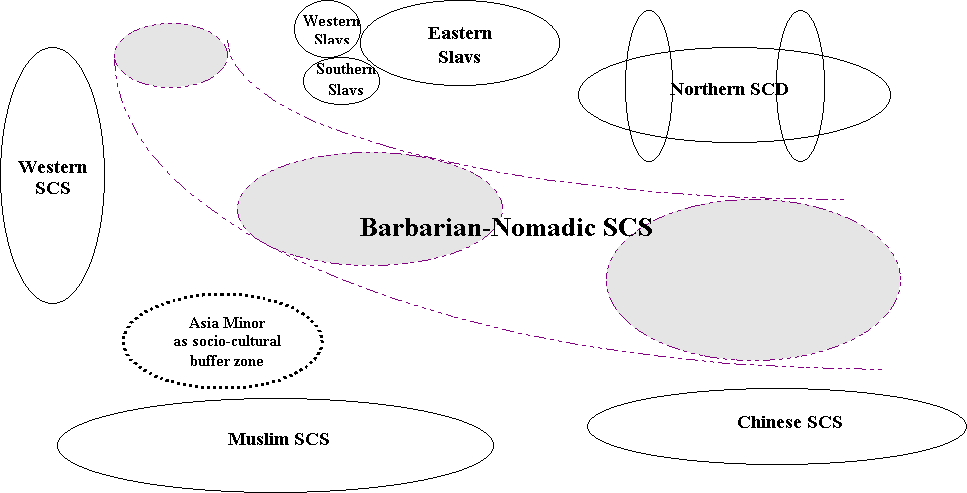
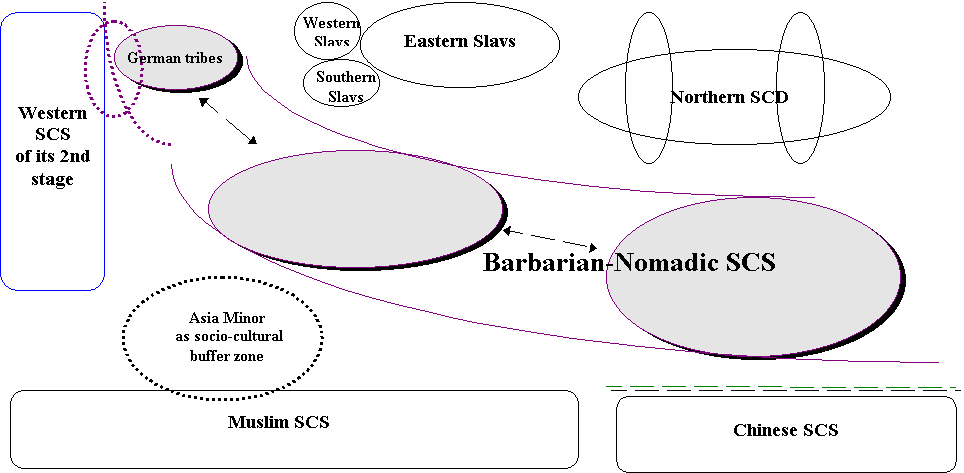
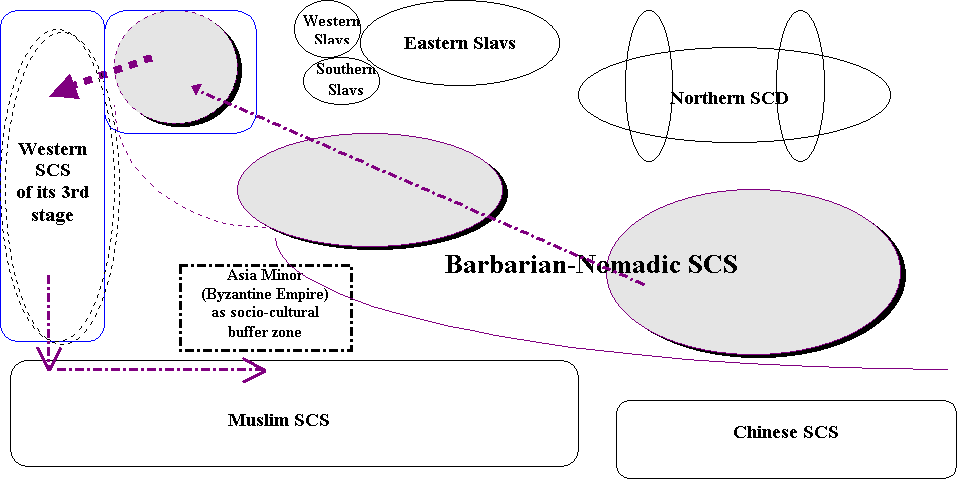

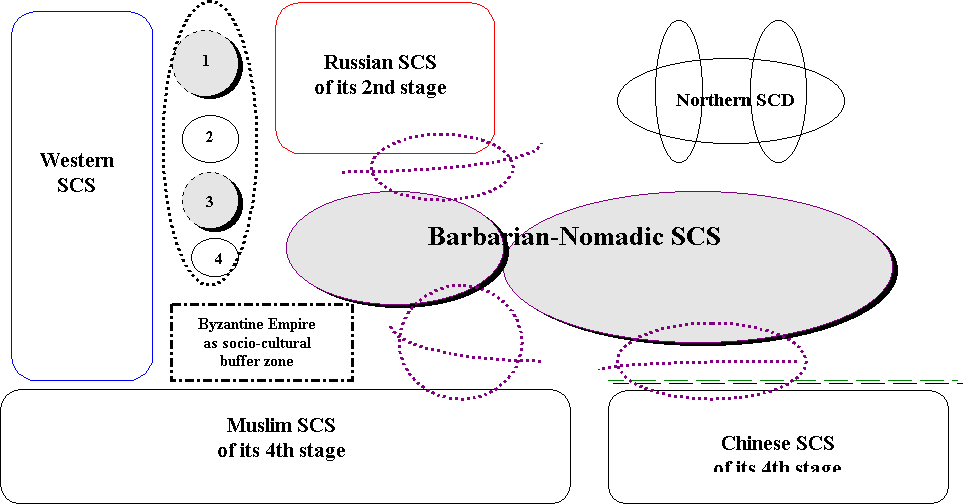
 (late XII century -
1380-s)
(late XII century -
1380-s)
